
"The Euphrat Museum is a cornerstone of the De Anza Community open to anyone and everyone. Not only is it a venue for student artists to be involved in a wide spectrum of its services, it provides a place for the community, students and residents alike, to participate in the most rewarding of human experiences. The Euphrat has acted as a catalyst for civic engagement and so many artistic endeavors."
| Clifford Dodd, De Anza art major |
Spring 2016
De Anza Student Art Show
May 2 - June 9
Reception and Awards Ceremony: Wednesday, May 18, from 5:30 to 7:30 p.m.
Open Monday - Thursday, 10 a.m. - 3 p.m., during exhibitions.
Open Saturday, June 4, 10 a.m. - 1 p.m., with a Community Art Station
Closed Monday, May 30, for Memorial Day.
Open to tour groups by appointment
1st Thursday open mic nights May 5 and June 2, from 5 to 8 p.m.
3rd Thursday film night May 19, from 5 to 8 p.m.
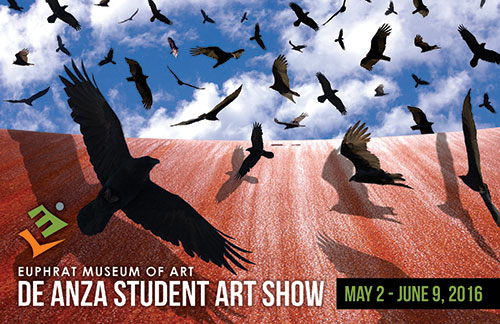
Artwork by David Litman
The exhibition features paintings, drawings, mixed-media works, photography, graphic design, furniture, sculpture, and ceramics created by students at De Anza College. The artworks reflect expertise in diverse media and varied interests and points of view.
Jurors for this year’s exhibition are from Santa Clara University:
• Julie Hughes, Professor, Drawing and Painting
• Ryan Carrington, Professor, Sculpture
Sponsored by De Anza Associated Student Body, the Euphrat Museum of Art and the Creative Arts Division.
Winter 2016
Burning Ice
Feb. 1 - March 17
Reception with artists, authors and live music Wednesday, Feb. 17 from 5:30 to 7:30 p.m.
Open Monday - Thursday, 10 a.m. - 3 p.m., during exhibitions
Open Saturday, March 5, 10 a.m. - 1 p.m. with a drop-in workshop, Climate Action Art Cards
Closed Monday, Feb. 15, for Presidents Day
Open to tour groups by appointment
Artist Presentation with Cheryl Derricotte Wednesday, Feb. 17 from 4:30 to 5:30 p.m.
Artist Presentation with Melanie Cervantes Tuesday, March 8 from 11:30 a.m. to 1:30 p.m.
1st Thursday open mic nights Feb. 4 and March 3, from 5 to 7:30 p.m.
3rd Thursday film nights Feb. 18 and March 17 from 6 to 8 p.m.
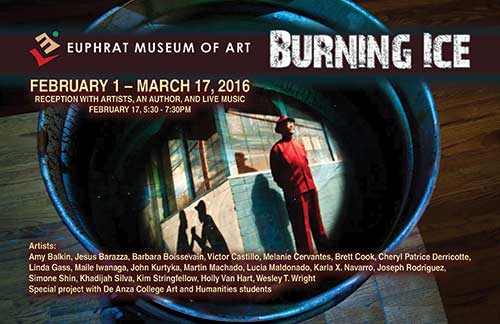
Announcement artwork by Barbara Boissevain, Oracles of Richmond series, 2014
Burning Ice explores impacts and causes of climate change from Richmond and East Palo Alto to the Arctic Circle. Artworks also honor nature and those who advocate on our behalf.
Artists: Amy Balkin, Jesus Barazza, Barbara Boissevain, Victor Castillo, Melanie Cervantes, Brett Cook, Cheryl Patrice Derricotte, Linda Gass, Maile Iwanaga, John Kurtyka, Martin Machado, Lucia Maldonado, Karla X. Navarro, Joseph Rodriguez, Simone Shin, Khadijah Silva, Kim Stringfellow, Holly Van Hart, Wesley T. Wright
Special project with De Anza College art and humanities students.
Burning Ice is presented in conjunction with Silicon Valley Reads 2016.
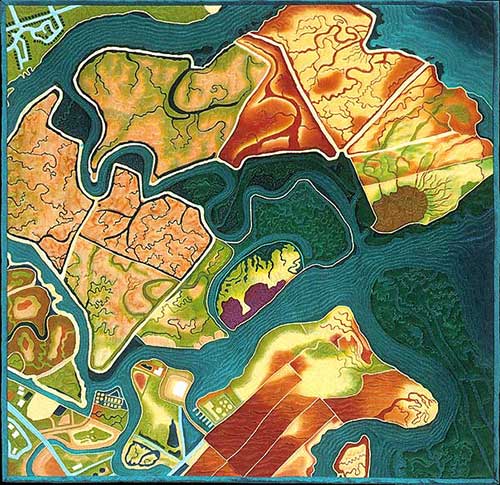
Puzzle of Salt, 2005 by Linda Gass, hand-painted silk, nylon thread
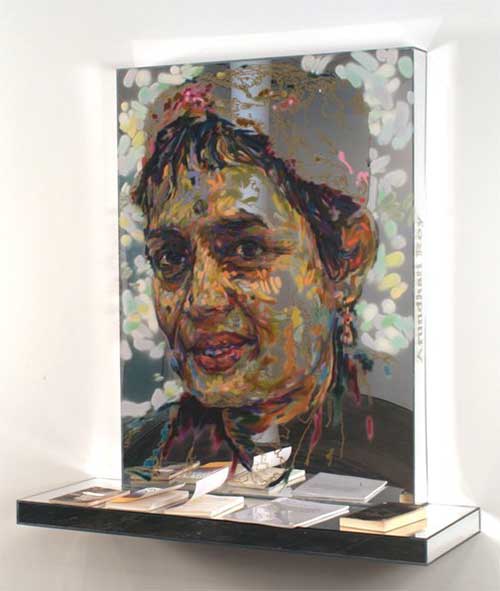
Arundhati Roy from The Models of Accountability/Divinity series, 2007 by Brett Cook, mixed media
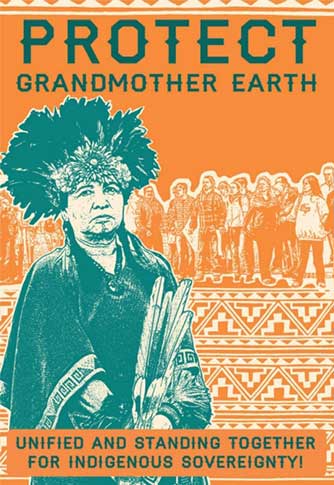
Protect Grandmother Earth, 2013 by Melanie Cervantes, silk screen print
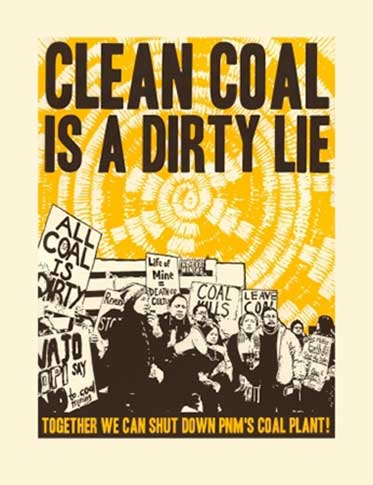
Clean Coal is a Dirty Lie, Jesus Barazza, silk screen print
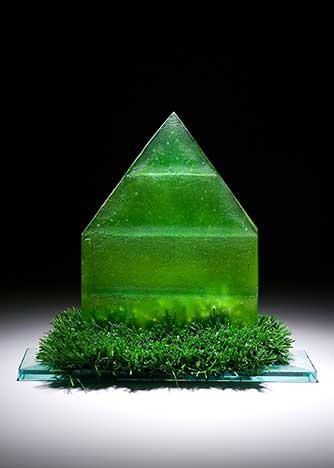
Future House, 2009 by Cheryl Derricotte, cast glass, mixed media
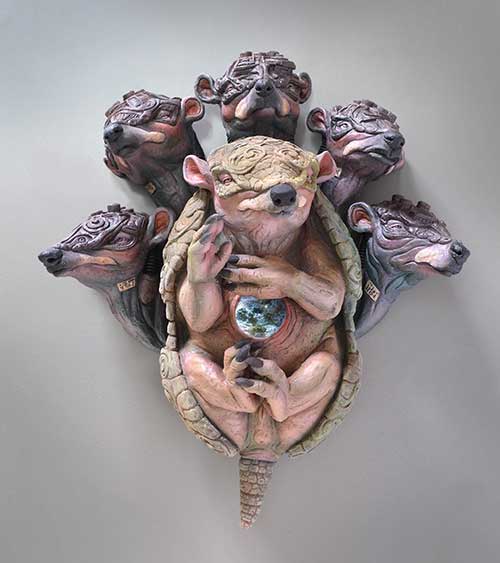
The Natural Paradox, 2015 by Wesley T. Wright, stoneware, glass, turf, LED light

Opportunity, 2014 by Holly Van Hart, oil paint on canvas
Fall 2015
Endangered
Oct. 19 - Dec. 3
Reception with artists and performance: Tuesday, Nov. 10, from 5:30 to 7:30 p.m.
Open Monday - Thursday, 10 a.m. - 3 p.m., during exhibitions.
Open Saturday, Nov. 7, 10 a.m. - 1 p.m. with a Community Art Station.
Closed Monday, Nov. 9, for Veterans Day.
Open to tour groups by appointment.
Taste of History benefit
Oct. 24, 3-6 p.m. Visual & Performing Arts Center
National Grand Slam Poet Champion Matt Sedillo Thursday, Nov. 19 from 1:30 to 3:30 p.m.
1st Thursday open mic nights Nov. 5 and Dec. 3, from 5:30 to 7:30 p.m.
3rd Thursday film nights Oct. 15 and Nov. 19 from 6 to 8 p.m.
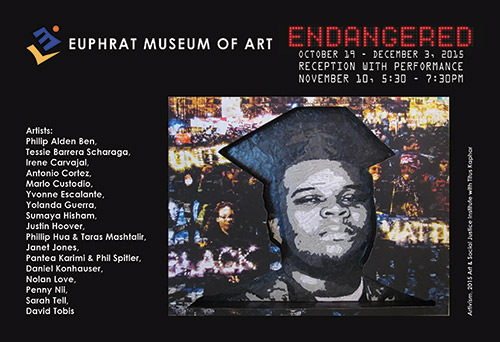
Artwork by Karla Vargas Gastelum and Amy Bam, 2015 Art & Social Justice Institute
Endangered looks at native languages on the brink of extinction and the evolving language of protest and participation.
Artists: Philip Alden Benn, Tessie Barrera Scharaga, Irene Carvajal, Antonio Cortez, Marlo Custodio, Yvonne Escalante, Yolanda Guerra, Sumaya Hisham, Justin Hoover, Phillip Hua & Taras Mashtalir, Janet Jones, Pantea Karimi & Phil Spitler, Daniel Konhauser, Nolan Love, Penny Nii, Sarah Tell, and David Tobis.
Artivism by 2015 Art & Social Justice Institute participants with visiting artist Titus Kaphar and special projects with De Anza College art and intercultural studies classes.
Co-curated with Hanna Regev.
Read the San Jose Mercury News review of Endangered.
Read the Campus Memo and FHDA Foundation Newsletter to learn more about the 2015 Art & Social Justice Institute.
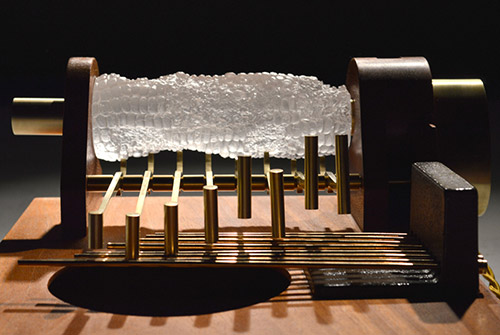
Keeping Time, 2015 by Yvonne Escalante, mixed media
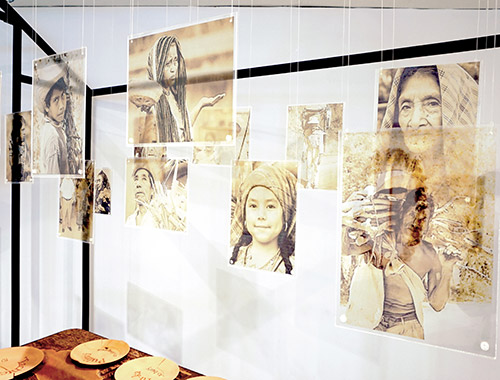
Detail of Nahua-Pipil, the Forbidden Language of El Salvador, 2014 by Tessie Barrera Scharaga, mixed media installation
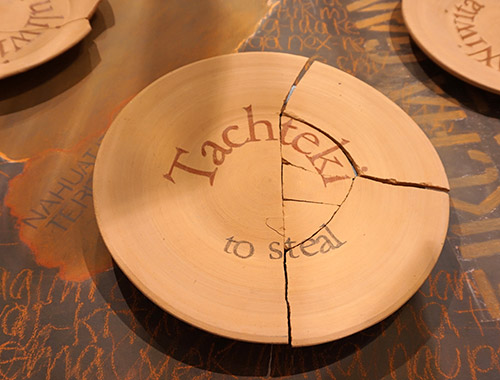
Detail of Nahua-Pipil, the Forbidden Language of El Salvador, 2014 by Tessie Barrera Scharaga, mixed media installation
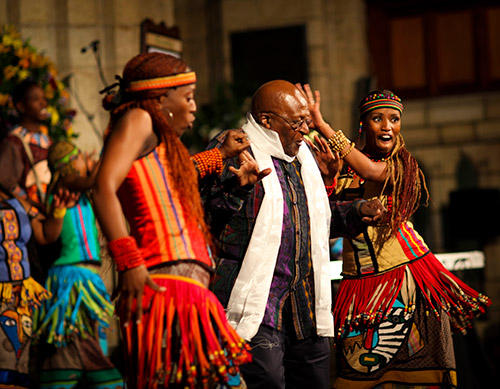
Archbishop Desmond Tutu Dancing, 2014 by Sumaya Hisham, photograph
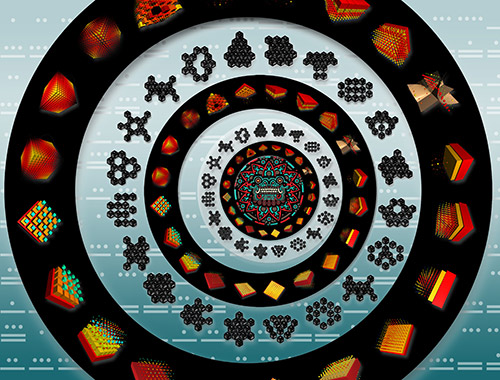
Still shot from The 3D Mathematical Mayan Calendar, 2014 by Antonio Cortez,
single channel video
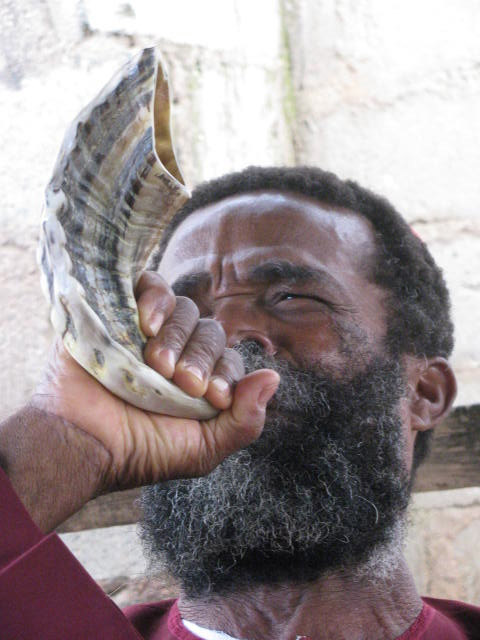
Abuja, Nijeria, 2013 by David Tobis, photograph
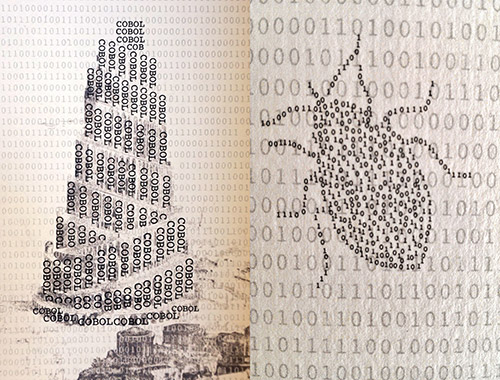
Detail of COBOL: The Life and Death Foretold of a Constructed Language, 2014 by Penny Nii, artists book
Spring 2015
De Anza College Student Art Show
May 4 - June 11
Open Monday - Thursday, 10 a.m. - 3 p.m., during exhibitions.
Open Saturday, June 6, 10 a.m. - 1 p.m., with a Community Art Station.
Closed Monday, May 25, for Memorial Day.
Open to tour groups by appointment.
Reception and Awards Ceremony: Wednesday, May 13, from 5:30 to 7:30 p.m.
1st Thursday open mic nights May 7 and June 4, from 5 to 7 p.m.
3rd Thursday film night May 21, from 5 to 8 p.m.
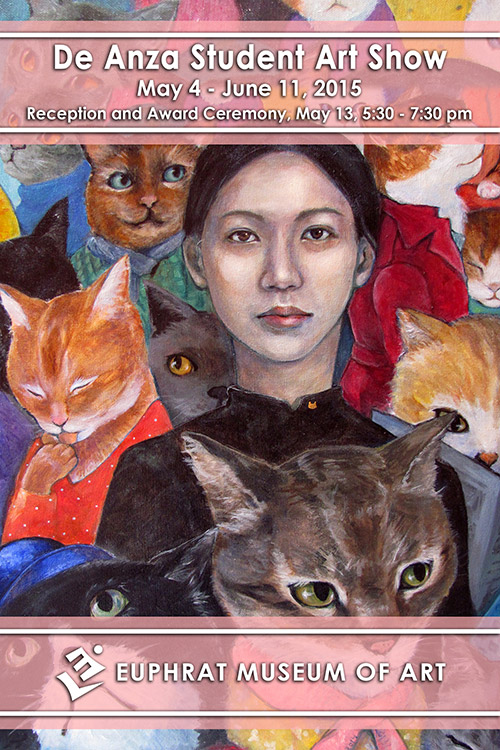
Winter 2015
Mooncakes, Churros, and Cherry Pie
Feb. 2 - March 19
Open Monday - Thursday, 10 a.m. - 3 p.m., during exhibitions.
Open Saturday, March 7, 10 a.m. - 1 p.m., with Soul Food Sculptures Community Art Workshop.
Closed Monday, Feb. 16, for Presidents Day.
Open to tour groups by appointment.
Reception: Wednesday, Feb. 18, from 5:30 to 7:30 p.m., with artists and an opening performance by Akoma Arts African Drum and Dance
Sweet & Sour presentation with author John Jung and artist Flo Oy Wong, Feb. 9, from 10:45 to 11:45 a.m., MQ-2A and 12:30 to 1:30 p.m., L36
Artist Presentation with sculptor Ann Weber, March 4, from 9:30 to 11:20 a.m., A71
Artist Presentation with photographer Binh Danh, March 19, from 12:30 to 1:30 p.m., A11
1st Thursday open mic nights Feb. 5 and March 5, from 5:30 to 7:30 p.m.
3rd Thursday film festival Feb. 19, from 6 to 8 p.m.
Cupertino Open House night with Moveable Feast event, Feb. 27, from 5:30 to 7:30 p.m.
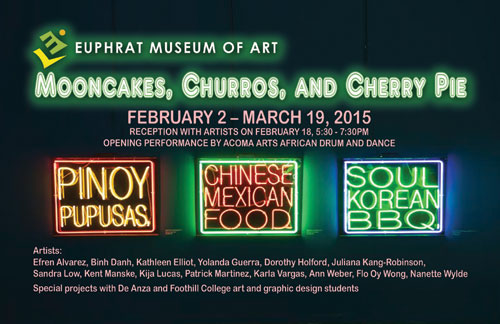
Melting Pot series, Patrick Martinez
Mooncakes, Churros, and Cherry Pie explores the connections between food, migration, and culture. Themes include food as a form of identity, the U.S. food industry and migrant/immigrant labor, and food traditions and memories. Artworks include neon, glass, and cardboard sculptures, photography, paintings, mixed media, textiles and more.
Artists: Efren Alverez, Binh Danh, Kathleen Elliot, Yolanda Guerra, Dorothy Holford, Juliana Kang-Robinson, Sandra Low, Kent Manske, Kija Lucas, Patrick Martinez, Karla Vargas, Ann Weber, Flo Oy Wong, and Nanette Wylde. Special projects with De Anza and Foothill College art and graphic design students and Homestead High School ceramics students.
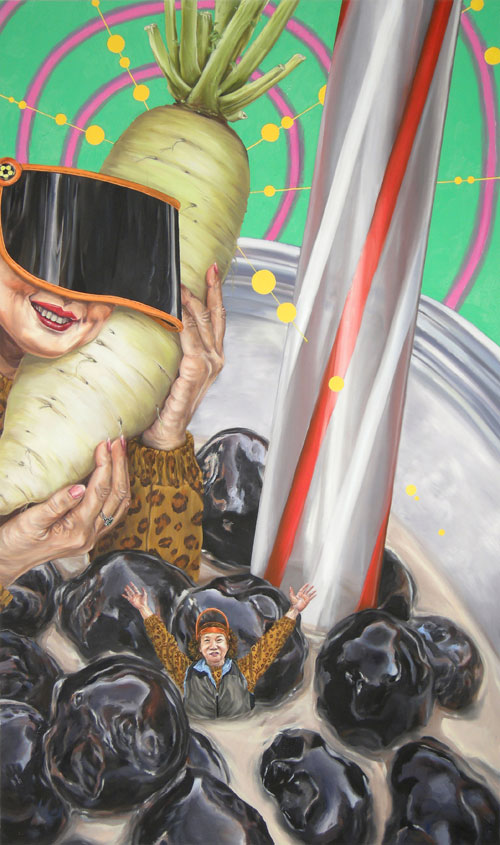
Always Delicious Best Friend by Sandra Low, oil on unstretched canvas, 56" x 34 3/4", 2008
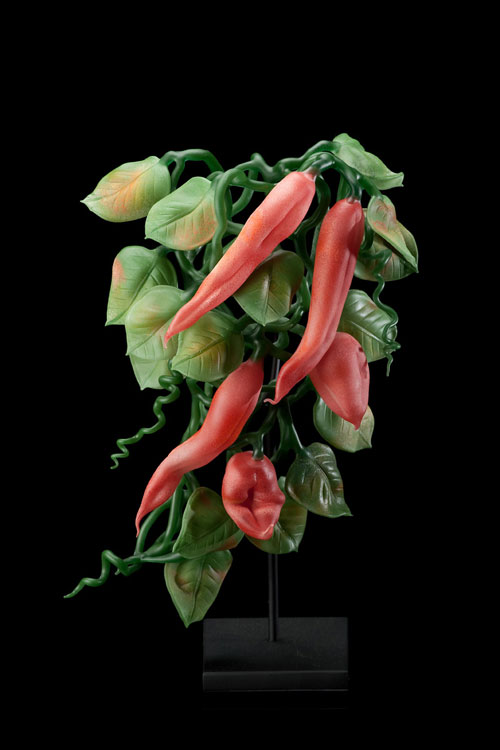
Peppers by Kathleen Elliot, glass, 9" x 5" x 4", 2008
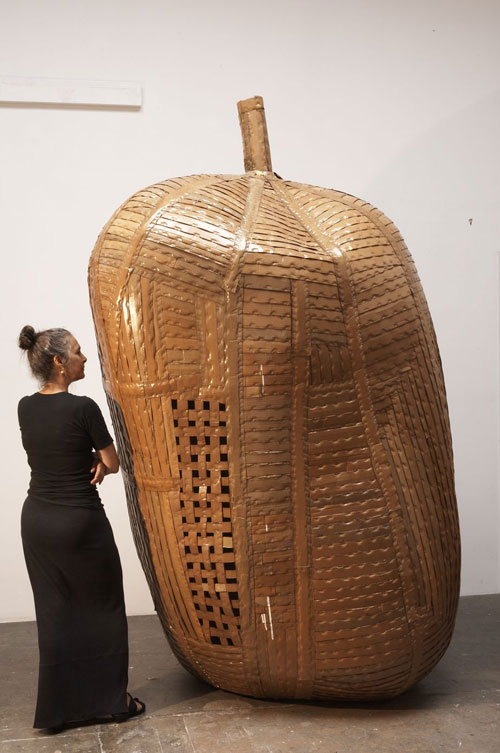
Big Strange by Ann Weber, cardboard, staples, shellac, 115" x 57" x 53", 2007
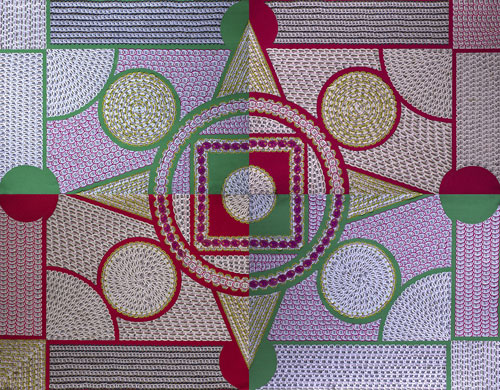
Mandala Rojo Verdez by Efren Alvere, fruit stickers, paper, 40" x 52", 2014
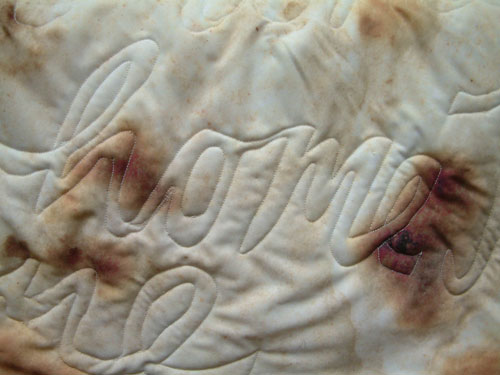
Closeup of "Home" Tortilla Quilt by Yolanda Guerra, cloth, thread, pigment, 2012
Mooncakes, Churros, and Cherry Pie is offered in conjunction with Silicon Valley Reads 2015. The program features three books with the theme Home & Homeland: The Immigrant Experience, including "Stealing Buddhas Dinner" by Bich Minh Nguyen, "We Need New Names" by NoViolet Bulawayo, and "The Book of Unknown Americans" by Cristina Henríquez. This annual community program encourages everyone in Santa Clara County to read the same book, at the same time, and talk about it. Presented by the Santa Clara County Office of Education, Santa Clara County Library District and the San Jose Public Library Foundation.
Sponsored by De Anza Associated Student Body, the City of Cupertino, the Friends of the Euphrat, and the Creative Arts Division.
Read the San Jose Mercury News review of Mooncakes, Churros, and Cherry Pie.
Fall 2014
De Anza & Foothill Faculty/Staff Art Show
Oct. 20 - Dec. 4, 2014
Open Monday - Thursday, from 10 a.m. to 3 p.m., during exhibitions.
Open Saturday, Nov. 1, from 10 a.m. to 1 p.m., for Community Art Station.
Open Thursday, Nov. 13, at 7 p.m., for Cupertino Poet Laureate event.
Open to tour groups by appointment.
1st Thursday open mic nights on Nov. 6 and Dec. 4, from 5 to 7 p.m.
3rd
Thursday film festivals on Oct. 16 and Nov. 20, from 5:30 to 7:30 p.m.
Reception with the artists: Wednesday, Nov. 5, from 5:30 to 7:30 p.m.
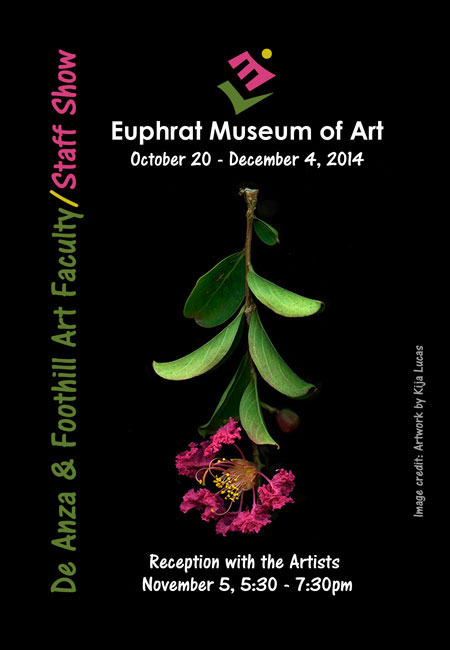
The De Anza and Foothill Art Faculty/Staff Show highlights the diverse yet interconnected work of art faculty and staff from De Anza College in Cupertino and Foothill College in Los Altos Hills. Painting, drawing, prints, mixed media, photography, sculpture, ceramics, and more will be on display. The fall exhibition also includes special projects with summer Artist-in-Residence Titus Kaphar and De Anza students in the Black Leadership Collective, and a Puente class Día de los Muertos installation.
Sponsored by De Anza Associated Student Body, the City of Cupertino, the Friends of the Euphrat, and the Creative Arts Division.
Spring 2014
De Anza Student Art Show
May 5 - June 12, 2014
Open Monday - Thursday, from 10 a.m. to 3 p.m., during exhibitions.
Open Saturday, May 10, from 9 a.m. to 1 p.m., for New Student and Parent Open House.
Open Thursday, June 12, at 7 p.m., for Cupertino Poet Laureate event.
Closed Monday, May 26, for Memorial Day.
Open to tour groups by appointment.
Reception and Award Ceremony: Wednesday, May 14, from 5:30 to 7:30 p.m.
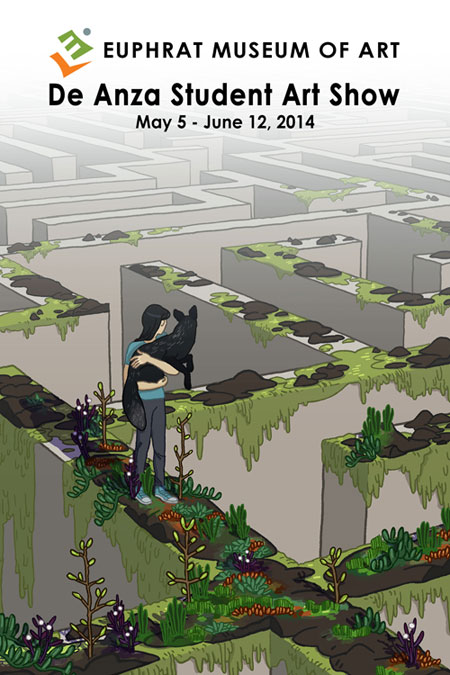
The exhibition features paintings, drawings, mixed-media works, photography, graphic design, sculpture, and ceramics created by students at De Anza College. The artworks reflect expertise in diverse media and varied interests and points of view.
Jurors for this year’s exhibition are from UC Santa Cruz:
Jimin Lee, Art Professor, Head of Print Media Program
Dee Hibert-Jones, Art Professor, Founder & Co-Director Social Practice Research Center
Juror’s Awards include:
Laurin Chichkanoff, Toronado – Beauty & Calamity Intertwined, steel nails
Megan Jerbic, The View From Above the Labyrinth, digital print
Yioulie Pappa, In the Shadows, photography
Adriana Serna, Toxic Collision, cut paper
Lisa Schichtel Orton, Fin Whales, stoneware
Lisa Teng, Untitled 1 from Alviso Series, gelatin silver print
Danielle Travers, The Aesthetic of Art, oil paint on canvas
Karla Vargas, True Faces of War, acrylic on canvas board
Steve Wilson, Chair, white ash, walnut, cotton
Martyna Ziemba, Mepe News Brochure, graphic design
Sponsored by De Anza Associated Student Body, the Euphrat Museum of Art, and the Creative Arts Division.
Winter 2014
Deep Reading
Feb. 3 - March 20, 2014
Open Monday - Thursday, 10 a.m. - 3 p.m., during exhibitions.
Open Saturday, March 1, 10 a.m. - 1 p.m., with a Artists' Books Workshop.
Open Thursday, Feb. 6, from 7-7:30 p.m. before the "Off the Page" Silicon Valley Reads event in the VPAC Theater.
Closed Monday, Feb. 17, for Presidents Day.
Open to tour groups by appointment.
Reception with artists and author Robin Sloan: Wednesday, Feb. 19, 5:30 - 7:30 p.m.
First Thursdays open mic nights: Jan. 9, Feb. 6, and March 6, 5 - 7 p.m. at the Euphrat.
Deep Reading looks at the intersection of humanity and technology and traditional practices in the digital age. Artworks include one-of-a-kind, small edition, and digital artists' books with computer woven tapestries, paintings, geolocation-based AR (augmented reality), prints, animation and sculpture.
Artists include Milton Bowens, Julie Chen and Flying Fish Press, Antonio Cortez, Wayne Jiang, Pantea Karimi, John Kurtyka, Marlene Larson, Magnolia Editions with Enrique Chagoya, Guy Diehl, and Hung Liu with Michael McClure, Kent Manske, Moonbot Studios, Jamila Rufaro, Vita Wells, Nanette Wylde, and Xiaoze Xie. Special installation with Chesa Caparas' Stanford Human Rights Education Initiative project and artists' books by De Anza College Art and Design students.
Deep Reading is presented in conjunction with Silicon Valley Reads, an annual community program that selects books with contemporary themes and offers free events across Santa Clara County. The 2014 theme is, "Books & Technology: Friends or Foe?" The books are Mr. Penumbra's 24 Hour Bookstore by Robin Sloan and The Shallows: What the Internet is Doing to Our Brains by Nicholas Carr.
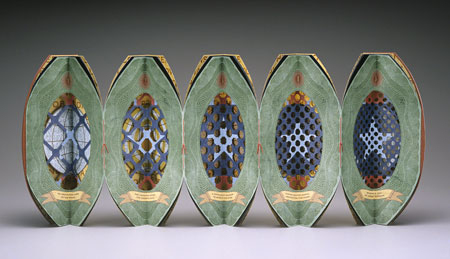
The Veil by Julie Chen
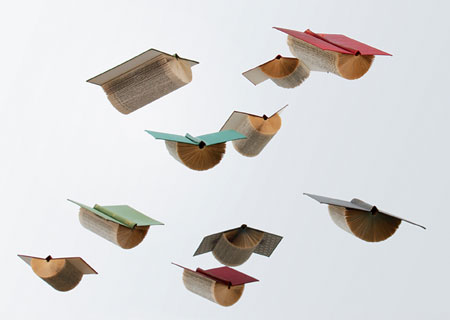
Flight 2 by Vita Wells
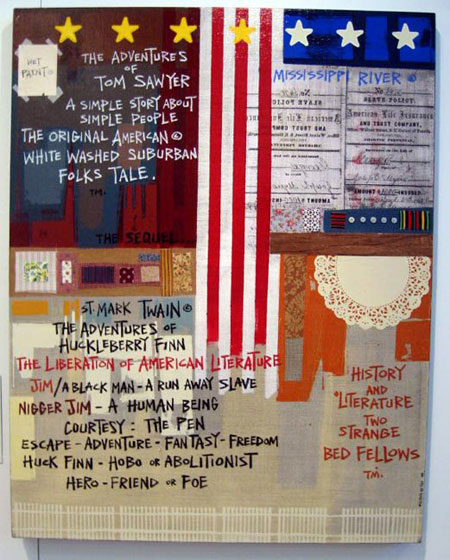
Tom Sawyer by Milton Bowens
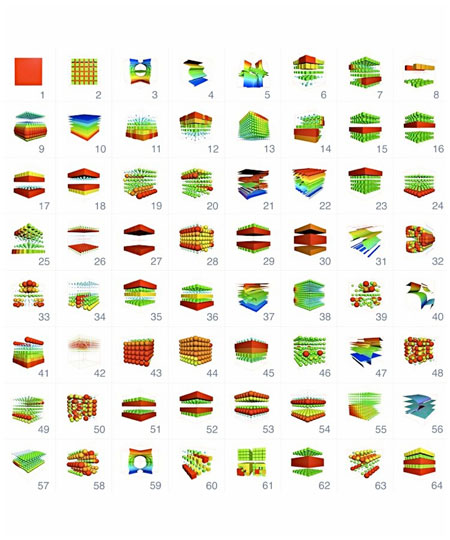
3D I Ching Chart by Antonio Cortez
Fall 2013
Making Space
Oct. 21- Dec. 5, 2013
Open Monday - Thursday, 10 a.m. - 3 p.m., during exhibitions.
Open Saturday, Nov. 2, 10 a.m. - 1 p.m., with a Community Art Station.
Closed Monday, Nov. 11 for Veterans Day.
Open to tour groups by appointment.
Reception with artists: Wednesday, Nov. 13, 5:30 - 7:30 p.m., with a performance by De Anza's Ballet Folklorico group.
Visiting Artist Presentations with Titus Kaphar, Nov. 13, 11:30 a.m. - 12:20 p.m. and 12:30 - 1:20 p.m. in the Visual & Performing Arts Center Theater (VPA 115).
The Third Thursday Film Festival presents the Created Equal: America's Civil Rights Struggle
film series from
6 - 8 p.m. at the Euphrat on the following dates: Oct. 17 - The Loving Story, Nov. 21 - Freedom Riders, and Dec. 12 - Slavery by Another Name. Join us for an evening of film and dialogue.
First Thursdays open mic nights: Oct. 3, Nov. 7, and Dec. 5, 5 - 7 p.m. at the Euphrat.
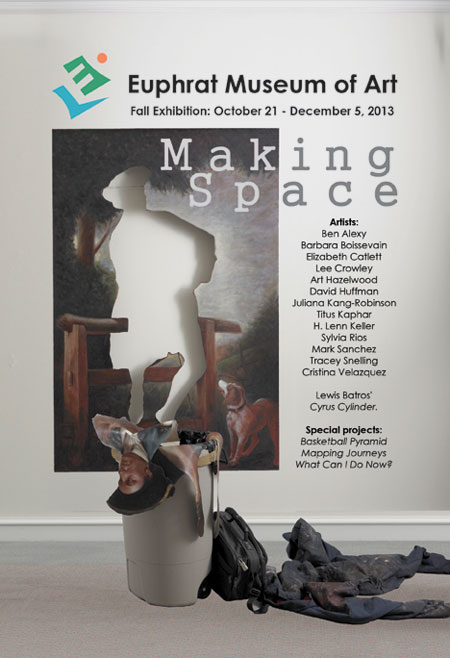
Making Space explores physical, cultural, and historic space. Artists include Ben Alexy, Barbara Boissevain, Elizabeth Catlett, Lee Crowley, Art Hazelwood, David Huffman, Juliana Kang-Robinson, Titus Kaphar, H. Lenn Keller, Sylvia Rios, Mike Sanchez, Tracey Snelling, and Cristina Velazquez, with Lewis Batros' sculpture of the Cyrus Cylinder.
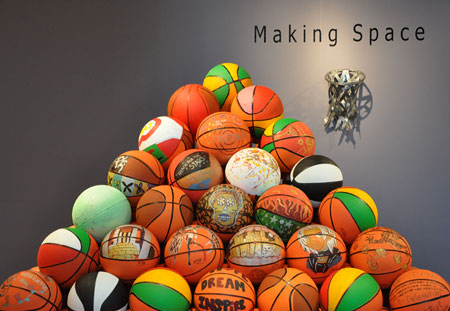
Special projects include Basketball Pyramid, No GPS in the CTZ (Critical Thinking Zone), and What Can I Do Now? with De Anza students from Puente, Sankofa Scholar, Color & Design, Intermediate Drawing, Gallery & Exhibition Design, and Internship in Art classes.
How can our shared spaces reflect community and invite participation? What is the arc and velocity of a great basketball shot? How can we make space for everyone?
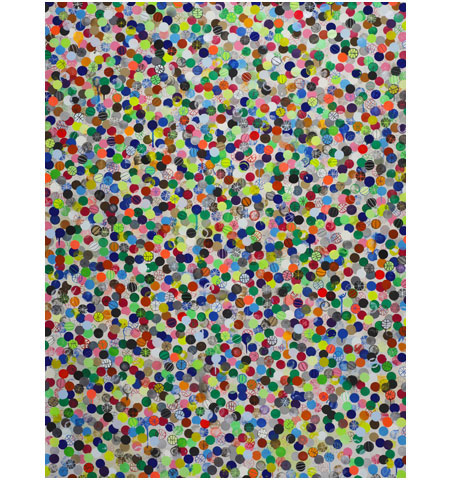
David Huffman, Faciazzle, 2012. Acrylic, oil, guache, printing ink, black light paint on canvas, 98" x 67."
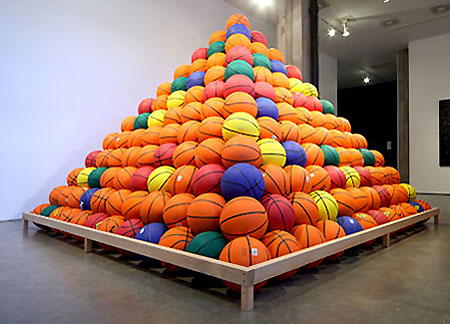
David Huffman, Basketball Pyramid, 2011. 650 basketballs, wood frame, 2012, 10' x 10' x 9.'
David Huffman's Basketball Pyramid brings an iconic image from his paintings into three dimensions. Here at the Euphrat we had De Anza students from Puente, Sankofa Scholars, and Gallery Exhibition Design classes draw on the basketballs commemorating those who have inspired us to reach for our dreams.
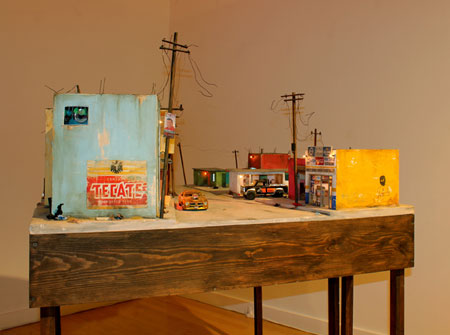
Tracey Snelling, Zaragoza y Obregon, 2007. Mixed media, 4' x 4.'
Tracey Snelling's dioramic scale-model sculptures, Obregon y Zaragoza and Strip Mall, present two working-class urban neighborhoods in Los Angeles and Mexico. Tiny scenes within give glimpses of the lives within.
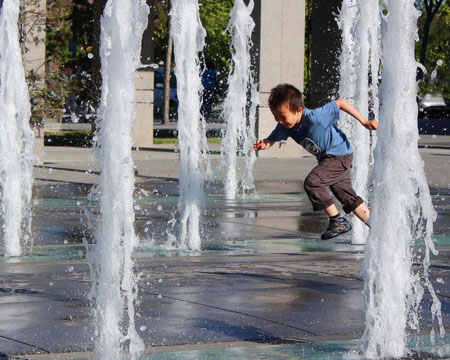
Mike Sanchez, Fountain, 2013. Photograph, 16" x 20."
Photographer and Cupertino Fine Arts Commissioner Mike Sanchez documents City of Cupertino public art and its environs. He looks at the role art plays in creating a sense of place.
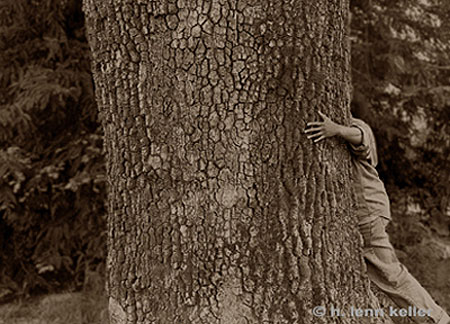
H. Lenn Keller, Tree Hugger, 2010. Photograph, 20" x 30."
H. Lenn Keller's photographic series, Marginal in Nature, looks at the experience and representation of contemporary black people in nature.
Spring 2013
De Anza Student Art Show
May 6 - June 13, 2013
Open Monday - Thursday, 10 a.m. - 3 p.m., during exhibitions.
Open Saturday May 11, 9 a.m. - 1 p.m., for New Student and Parent Open House.
Open Saturday and Sunday, May 18 and 19, 11 a.m. - 5 p.m., for Open Studios Weekend.
Closed Monday, May 27 for Memorial Day.
Open to tour groups by appointment.
Reception and Award Ceremony: Wednesday, May 22, 5:30 - 7:30 p.m.
The exhibition features paintings, drawings, mixed-media works, photography, sculpture, ceramics, furniture, and more created by students at De Anza College. The exhibition is presented in conjunction with the Arts 72 Internship in Art class.
The jurors are Kathryn Funk, curator, and Angelica Muro, Assistant Professor of Integrated Media & Photography, California State University Monterey Bay.
Sponsored by De Anza Associated Student Body, Friends of the Euphrat Museum of Art, Creative Arts Division, and the City of Cupertino.
Visit Arts & Leadership Presentations for additional events.
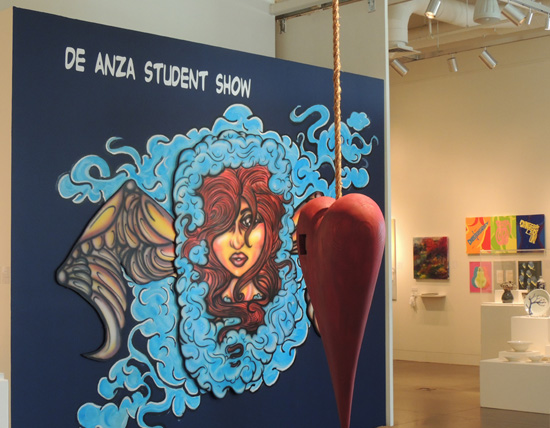
Winter 2013
War & Healing
February 4 - March 21, 2013
Open Monday - Thursday, from 10 a.m. - 3 p.m. during exhibits
Open Saturday, March 2, from 10 a.m. - 1 p.m. with a Community Art Station
Closed Monday, Feb. 18
Open to tours by appointment
Reception with the artists: Wednesday, Feb. 27, from 5:30 - 7:30 p.m. with printmaking demonstrations by Diego Marcial Rios
Combat Paper workshops with co-founder Drew Cameron, Euphrat Museum of Art, March 7 and 9, from 10 a.m. - Noon. and 12:30 p.m. - 2:30 p.m.
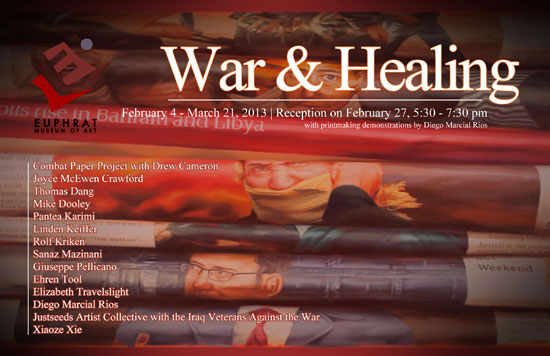
Artists: Combat Paper Project with co-founder Drew Cameron, Joyce McEwen Crawford, Thomas Dang, Mike Dooley, Pantea Karimi with Daniel Konhauser, Linden Keiffer, Rolf Kriken, Sanaz Mazinani, Giuseppe Pellicano, Ehren Tool, Elizabeth Travelslight, Diego Marcial Rios, the Justseeds Artist Collective with the Iraq Veterans Against the War, and Xiaoe Xie.
War & Healing looks at war and the healing potential of art. Many of the artists have lived through war firsthand. Three focus on social and internal war. They examine the effects of war on everyone, tell stories, and document global history. Art-making is used as an integral part of the healing process. War & Healing invites us to examine our own perceptions about war and reaffirm our sense of humanity.
Special projects include a collaborative mural by Eugene Rodriguez's design students and winning entries from the Sakhaa On-the-Spot Peace Art Contest.
A concurrent display at the California History Center features The Art of Protest, a collection of 1960's and 70's protest posters from the San Jose Peace and Justice Center.
War & Healing is offered in conjunction with Silicon Valley Reads 2013. The program features two books that describe the invisible wounds of war, The Long Walk by Brian Castner and Minefields of the Heart by Sue Diaz.
Read the New York Times, Ultra Extra, and Sunnyvale Sun reviews of War & Healing.
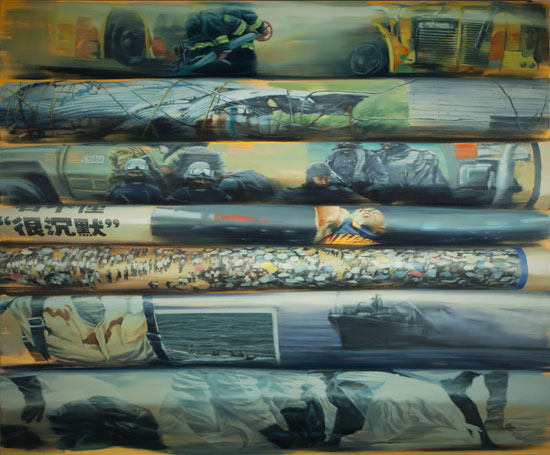
Xiaoze Xie, April-December 2008, Guangzhou Ri Bao, 2011. Oil on canvas, 78” x 96.”
Xiaoxe Xie's oil paintings depict stacks of newspapers, each revealing a section of cover image over a specific period of time. War-related images are standard daily fare. He raises questions about how we perceive the world through the media and what ideologies are imbedded in those pages.
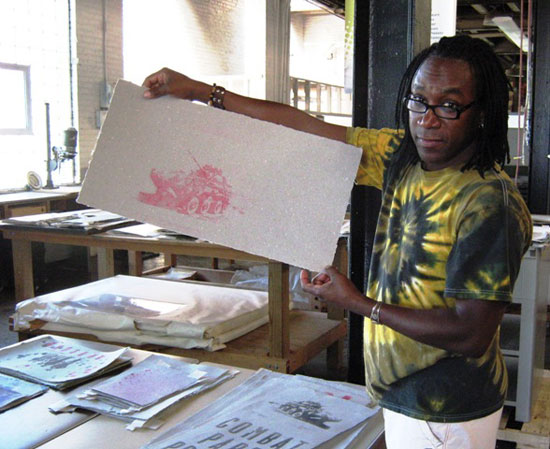
The Combat Paper Project utilizes art-making workshops to assist veterans in reconciling and sharing their personal experiences as well as broadening the traditional narrative surrounding service and the military culture. Through papermaking workshops veterans use their uniforms worn in combat to create cathartic works of art.
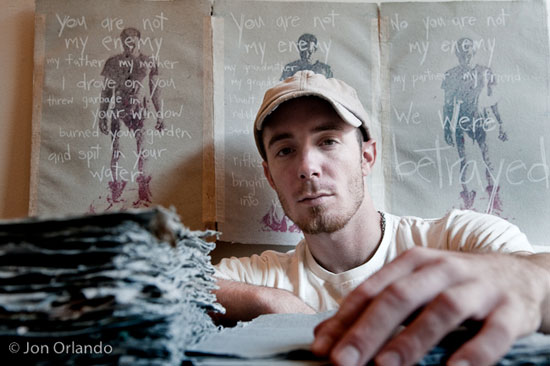
Combat Paper co-founder and papermaker Drew Cameron exhibits a selection of his own Combat Paper works. In 2004, upon returning from serving as a field artillery soldier in Iraq, he took Drew Matott's papermaking workshop at the Green Door Studio in Vermont. The Combat Paper Project grew from their collaboration and today he travels across the United States and abroad presenting Combat Paper workshops, residencies, and exhibitions.
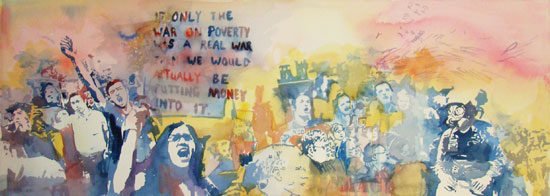
Pantea Karimi, There Are Many Kinds of War, 2012. Watercolor on paper, 11” x 29.”
Pantea Karimi's watercolor paintings focus on recent uprisings around the world from Occupy protests in Zuccotti Park to the Arab Spring in the Middle East. They also reference her own childhood in revolutionary and post-revolutionary Iran. A digital animation, The Hubbub of Human Magma, incorporates imagery from her watercolor paintings with an original soundtrack by Daniel Konhauser. For War & Healing Karimi also created Middle of Nowhere: Locating a Retained Memory, a new digital installation that examines her father's Iran-Iraq War experiences and near fatal injuries.
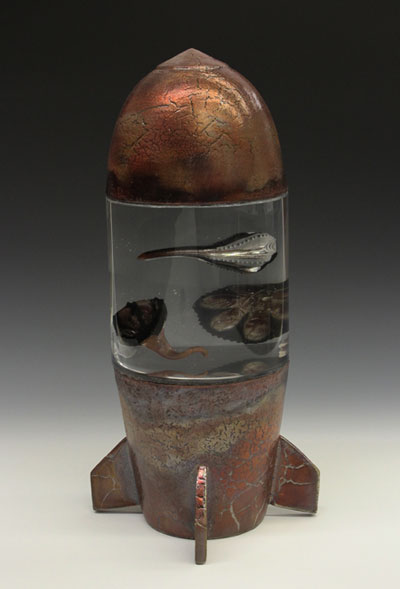
Thomas Dang, Raku Bomb #18, 2011. Clay, mixed media, 12” x 5” x 3.”
Thomas Dang's ceramic/mixed-media sculptures serve as a reminder of the catastrophic events biological and chemical weapons can cause. Raku-glazed 'bombs' containing super-enlarged models of pathogenic organisms are suspended mid-air. In Dang's time with the Marine Corps he has done two combat tours in Iraq and has seen many hostile engagements. Biological and chemical warfare training gave him insight into their devastating potential and inspired a continuing study.
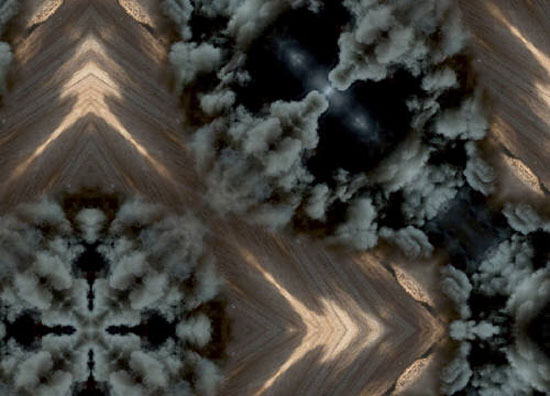
Sanaz Mazinani, Clouded Libya (detail), 2012. Digital photograph, 31” x 31.”
Sanaz Mazinani's digital photo-based installations investigate cognitive awareness and challenge the viewer to look at how our perceptions of war and enemy are formed. Clouded Libya features kaleidoscopic digital patterns made from images of military explosions over the Libyan desert. Threshold #1 - 4 draws from four recent news media images of explosions. She writes, "The symbolic likeness of an explosion stands in for an act of violence, but also for depictions of power that are sublime and awe-inspiring. We are surrounded by a culture of fetishism of weapons."
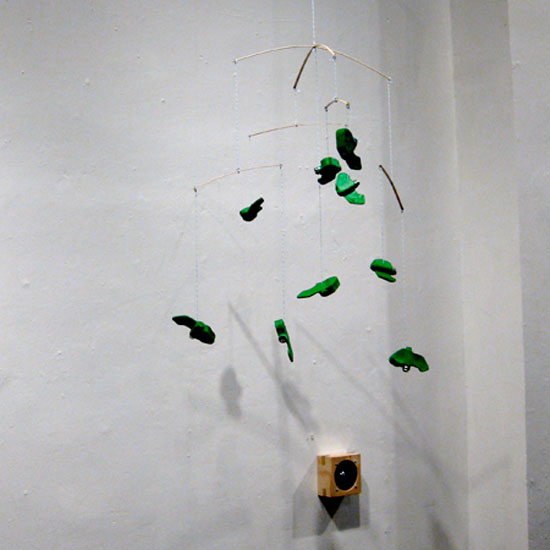
Elizabeth Travelslight, green parrots, 2011. Mixed media, c. 24” x 30.”
Elizabeth Travelight's installation, green parrots, addresses the widespread phenomena of anti-personnel mine casualties among young boys in Afghanistan. It exposes the, all too often, traumatic effects of childhood learning and play in worn-torn countries. Suspended like a child's mobile, floating paper-mache green parrot 'mines' cast shifting shadows onto a sky-blue wall. An audio component captures conversations among boys recuperating in EMERGENCY's Surgical Center for War Victims, Kabal, Afghanistan.
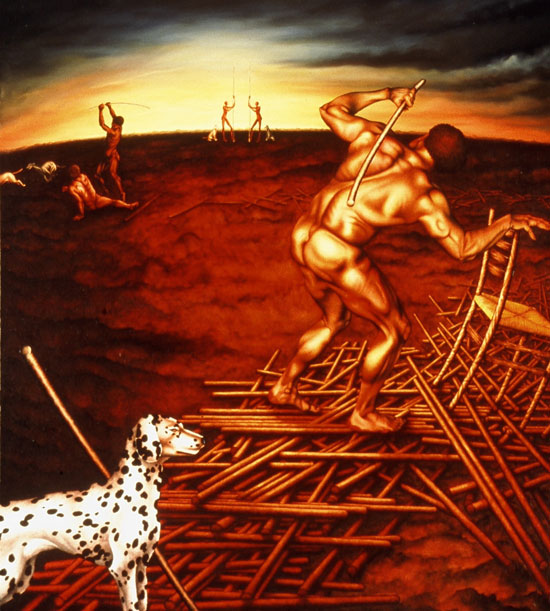
Linden Keiffer, The Reckoning, 2003. Oil on canvas, 62” x 67.”
Linden Keiffer's oil painting, The Reckoning, refers to inner wars and primal battles of acceptance. A lone figure climbs over a trail of battered wooden staffs, ruins of past struggles. The short story that inspired his painting describes the evolution of human violence and offers resolution through integration, a symbolic union of "human, beast, and staff." The Reckoning also points to a future where all humans are multi ethnic and free to live in peace. Keiffer is co-founder and president of The You In Me, Inc., a non-profit organization that focuses on art, multi racial/ethnic, and multicultural education.
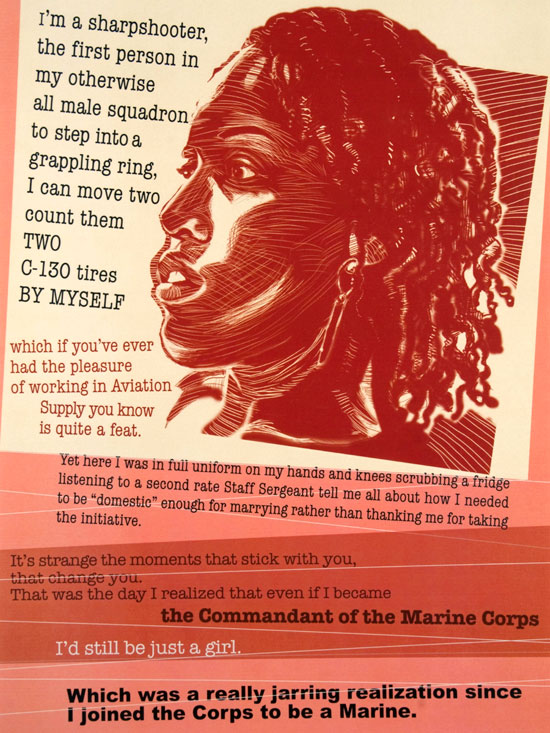
Siri Maggerin, I’m a Sharpshooter: Chantelle Bateman, 2011. Silkscreen print, 16” x 12.”
War Is Trauma is a portfolio of handmade prints produced by the Justseeds Artists' Cooperative in collaboration with the Iraq Veterans Against the War. This portfolio transpired out of a street poster project, "Operation Recovery", a 2010 campaign to stop the deployment of traumatized troops and win service members and veterans right to heal. Posters were pasted in public, replacing many corporate advertisements, to focus public attention towards the issues not being discussed - GI Resistance, Post Traumatic Stress Disorder (PTSD), sexual assault in the military or Military Sexual Trauma (MST), and Traumatic Brain Injury (TBI).
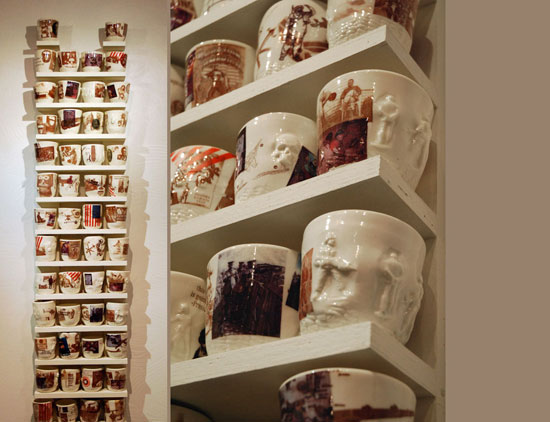
Ehren Tool's ceramic cup installations seek to raise awareness of war and popular images of war. He points to children's toys such as, "Bombs Away," a miniature CBU-87 cluster bomb toy recommended for ages 10 and up. His cups also commemorate those who died in combat and he has given away thousands of them as a part of his artistic process. Tool says, "Drink out of the cup with bombs or skulls on it. We don't have money for schools or prisons that truly rehabilitate but we do have money for million-dollar Tomahawk missiles. Every single one of us is a part of that system." Tool is a third-generation soldier who served in Desert Storm.
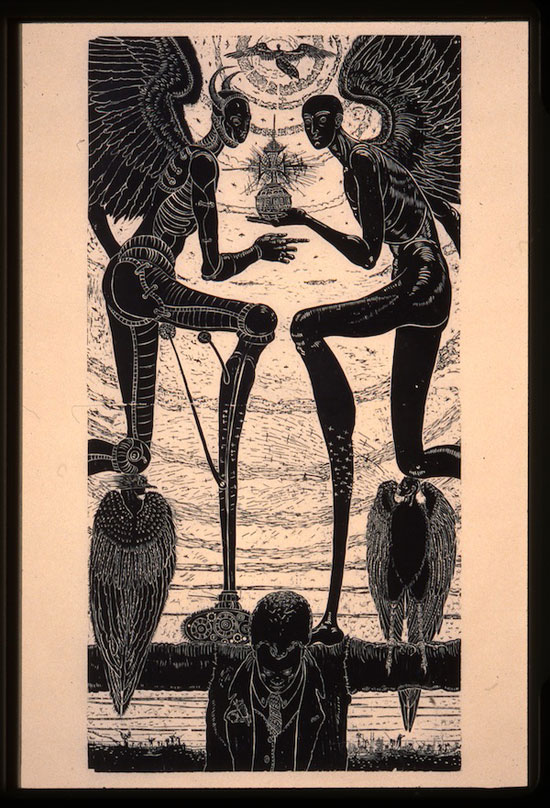
Diego Marcial Rios, It Must Be Angels, 2010. Woodcut print, 3’ x 2.’
Diego Marcial Rios' woodcut prints merge politics and faith and decry the effects of war on all peoples. His 6ft print, It Must be Angels, illustrates a moral struggle between the vast profits of a militarized economy and the humanitarian desire for peace. Ancient and contemporary symbols for life and death confront the viewer in Tell the Sky and Flute of Death. Rios addresses violence and suffering that he has witnessed and advocates for social and economic reforms.
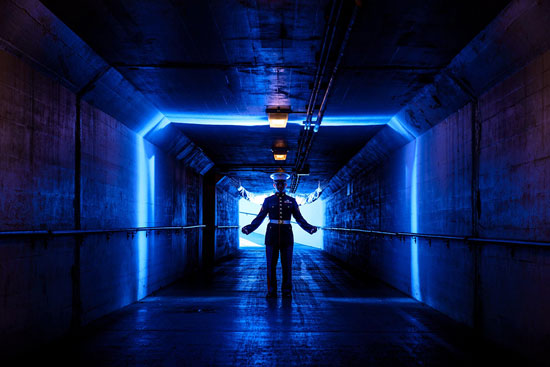
Mike Dooley, Friends, 2012. Digital photograph, 20” x 30.”
Mike Dooley's digital collages look at life after serving including the high rates of suicide amongst veterans. In Friends, a soldier moves through a dark urban tunnel back-lit by a band of cold blue light. Dooley writes, "A soldier meets many people and accepts many things over their career. As they walk down the path of conflict and war they become intimate with the only certainty of life." He chronicles his own transition back to the civilian world and addresses issues facing soldiers and veterans today. Dooley is an 82nd Airborne veteran and a Bronze Star recipient.
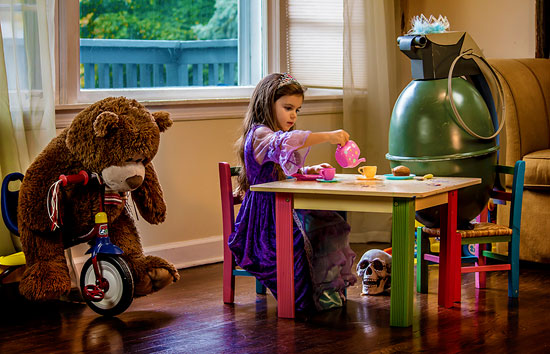
Giuseppe Pellicano, Tea Time, 2012. Photograph, 18” x 28.”
Giuseppe Pellicano's photographic series Grenade illustrates the effects of Post Traumatic Stress Disorder on soldiers and their families. A large-scale grenade sculpture symbolizes reintegration into civilian life. In Teatime, a young girl plays tea with the grenade, a tiara on its crown. Gifts From Dad features two small boys engaged in warfare play on Christmas morning, the grenade looking on. Pellicano is a U.S. Army veteran who served in Kosovo, Germany, and California.
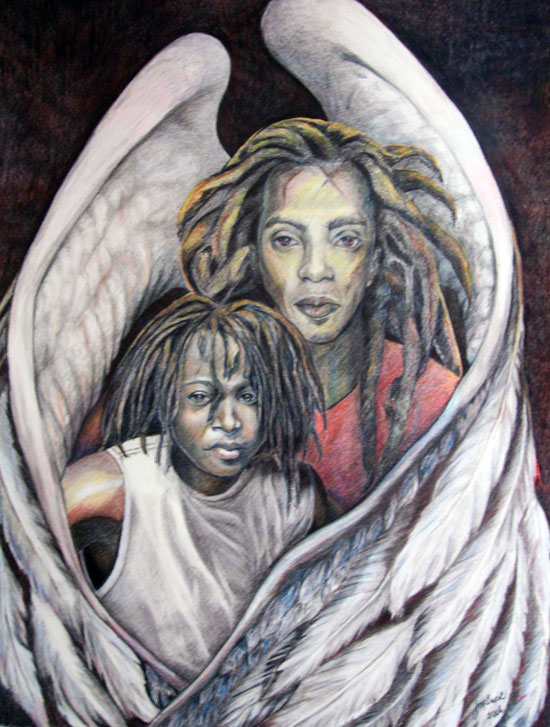
Joyce McEwen Crawford, The Guardian, 2009. Graphite, colored pencil, 30” x 22.”
Joyce McEwen Crawford's drawing, The Guardian, was inspired by African and American Indian stories of ancestral and guardian spirits. She writes, “As adults, we are all “guardian angels.” As a social worker, I saw many children removed from harm and placed with guardians, earthly angels, who would care for them, love and protect them, speak on their behalf and assist in their healing. The angelic image in The Guardian surrounds the child with its wings, baring his scars, protecting him when he could not protect himself.”
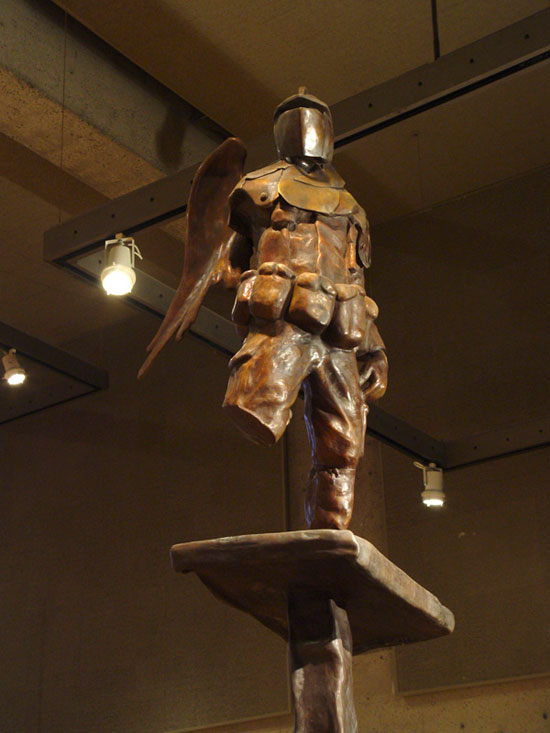
Rolf Kriken, Prophesy, 2012. Bronze, 11’ 4” base 3’ x 3.’
Rolf Kriken's bronze sculptures honor America's veterans and point to the devastating effects of war. His sculptures incorporate soldier’s faces, Army code, weaponry, and other war objects. He served in the Army during the Vietnam War and is best known for his bronze sculptures at the California Vietnam Veterans Memorial in Sacramento. Referring to his work on memorials, Kriken told youngsters attending a career day presentation, "Put me out of business (by making sure no more wars occur) so your names won't end up on a wall."
Fall 2012
The Art of Education: De Anza and Foothill Art Faculty/Staff Show
October 22 - December 7, 2012
Open Mon.-Thurs. 10 a.m. - 3 p.m. during exhibits
Open Saturday, Nov. 3, from 10 a.m. - 1 p.m. with a Family Art Station
Open to tours by appointment
Reception with the artists and silent auction: Wednesday, Oct. 24, 5:30 - 7:30 p.m.
The Art of Education exhibition will highlight the diverse yet interconnected work of art faculty and staff from De Anza College in Cupertino and Foothill College in Los Altos Hills. Painting, drawing, prints, mixed media, photography, sculpture, ceramics, and more will be on display. Also included will be Pick Up Your Pencils, Begin by Visiting Artist Harriete Estel Berman.
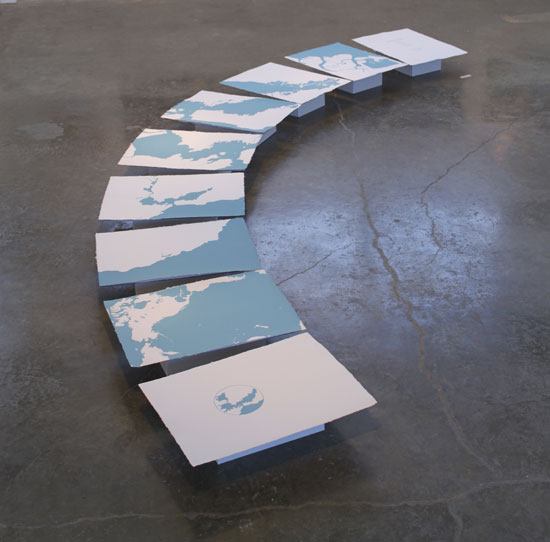
Kent Manske, San Francisco Bay, 2012. Portfolio of screen prints.
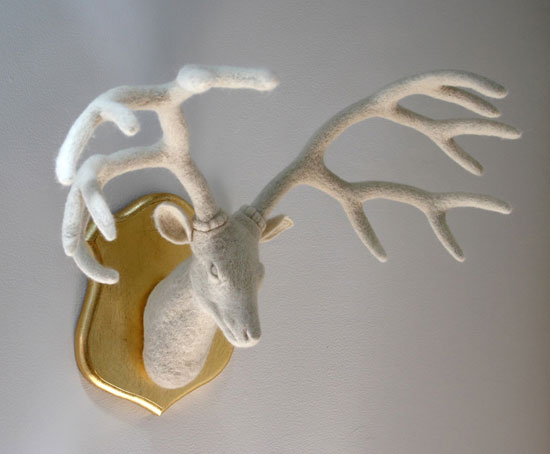
Masako Miki, Growing Antlers Against Her Wish, 2012. Wool on composition leafed wood panel.
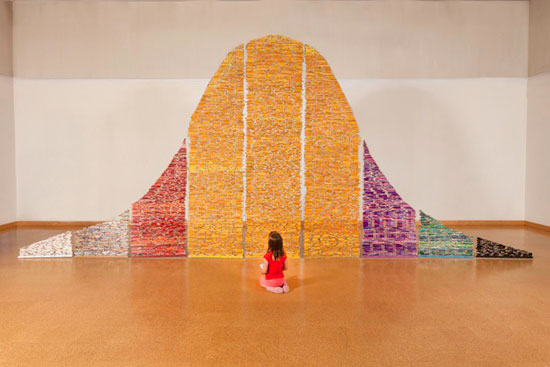
Harriete Estel Berman, Pick Up Pencils, Begin, 2012. #2 pencils and monofilament fishing line.
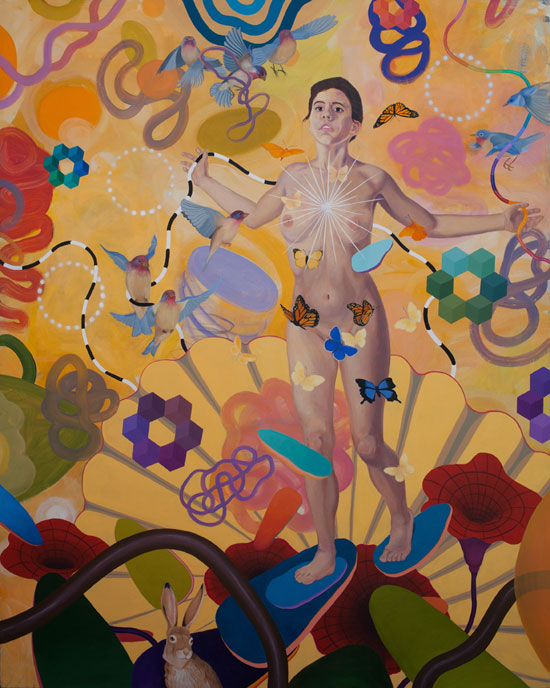
Mark Engel, Birth of the New, 2012. Oil on canvas.
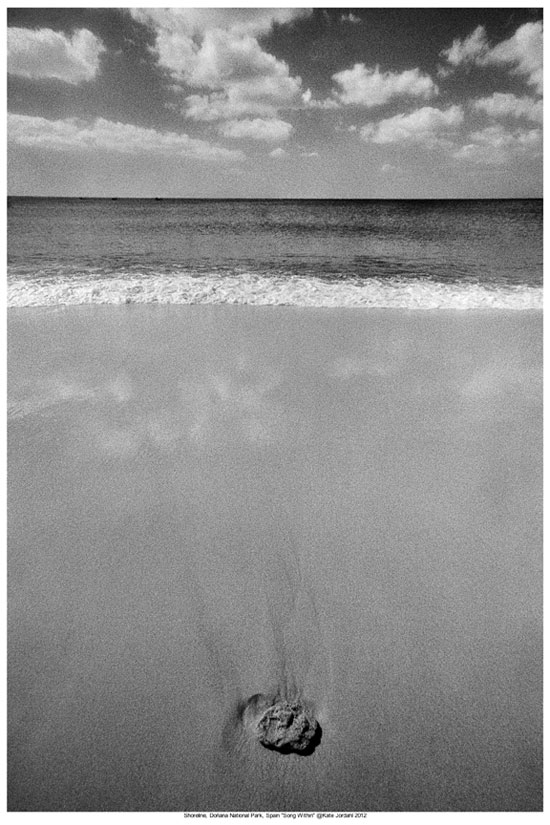
Kate Jordahl, Song Within, 2012. Photography.
Summer 2012
Don't Be Afraid of Love
Project took place in July and August. Private reception. Open by appointment in August. Santa Clara County youth in the Foster Care system participated.
The Don’t Be Afraid of Love exhibition at the Euphrat Museum of Art featured artworks created by students in De Anza's 2012 Summer Bridge program. They began by directing, acting, and staging shadow theater scenes. Select images were then used as inspiration for a series of art projects including collaborative paintings, light-boxes with poetry, and a book. The students drew from their own wisdom and life experiences expressing love, fear, and faith.
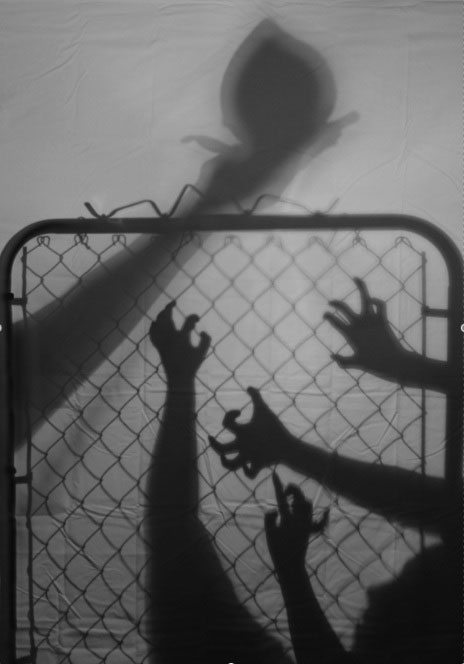
Summer Bridge Project, Equity, 2012. Photograph of shadow theater scene.
Spring 2012
De Anza Student Art Show
May 8 - June 14, 2012
Open Mon. - Thurs. 10 a.m. - 3 p.m. during exhibitions.
Open Saturday, May 12 from 9 a.m. - 1 p.m., with ongoing tours led by members of the Gallery Exhibition Design class.
Closed Memorial Day, Monday, May 28
Reception and Awards Ceremony: Tuesday, May 22, 5:30 p.m. - 7:30 p.m.
The exhibition features paintings, drawings, mixed-media works, photography, graphic design, sculpture, ceramics, furniture, and more created by students at De Anza College. The exhibition is presented in conjunction with the Gallery and Exhibition Design class.
The jurors are Gale Antokal, Program Head for Pictorial Art at San Jose State University; Ala Ebteckar, visual artist and visiting faculty at Stanford University; and Xiaoneng Yang, Ph.D., Curator of Asian Art, Cantor Center for Visual Arts at Stanford University.
Sponsored by the De Anza Associated Student Body, the Euphrat Museum of Art, and the Creative Arts Division.
Winter 2012
Invoking Peace
Feb. 3 - March 17, 2012
Open Mon.-Thurs. 10 a.m. - 3 p.m. during exhibits
Open Saturday, March 3, 10 a.m - 1 p.m. with Community Art Station
Open Saturday, March 11, Noon - 2 p.m. before Sounds of the Soul film presentation
Open to tours by appointment
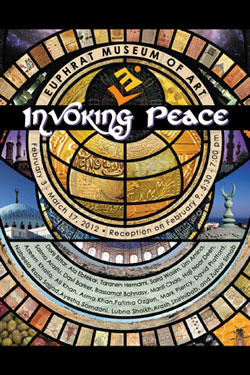 Reception: Thursday, Feb. 9, 5:30 - 7 p.m. with calligraphy demonstrations by Zubair Simab Reception: Thursday, Feb. 9, 5:30 - 7 p.m. with calligraphy demonstrations by Zubair Simab
Invoking Peace interweaves tradition, innovation, faith, and activism. It emphasizes the immense diversity of Islamic art and reveals shared concerns. Traditional and hybrid calligraphy is combined with site-specific installations, animation, graphic design, a collaborative mural, and more. This shared call for peace brings together artists from around the globe and throughout the Bay Area.
Artists include: Seyed Alavi, Doris Bittar, Ala Ebtekar, Taraneh Hemami, and Saira Wasim with Legacy of Qur'an: Messages of Peace artists Um Amina, Salma Arastu, Davi Barker, Bassamat Bahnasy, Manli Chao, Haji Noor Deen, Azeem Khaliq, Ali Khan, Asma Khan, Fatima Ozgun, Mark Piercy, David Platford, Nabeela Raza Sajjad, Ayesha Samdani, Lubna Shaikh, Arash Shirinibab, and Zubair Simab.
The title wall features Occupy Everywhere, a collaborative mural by Color and Design students with De Anza College art professor Eugene Rodriguez.
Presented in conjunction with Silicon Valley Reads 2012 and the Islamic Art Exhibit.
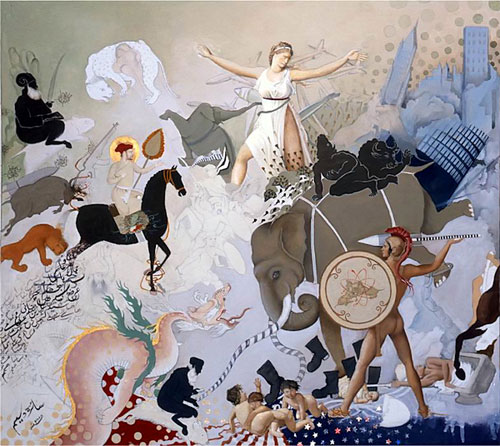
Painting by Saira Wasim, Plea for Peace, 2008. Gouache, gold leaf, ink on tea stained wasli paper, 21.5" x 22.8 "
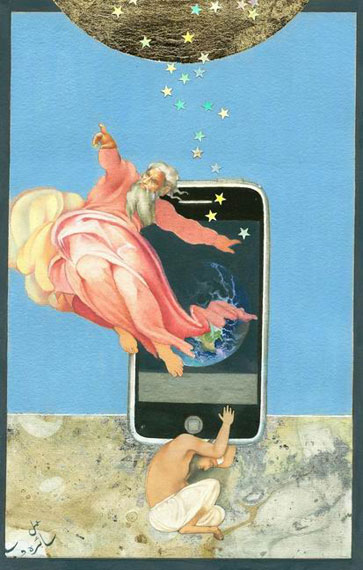
Painting by Saira Wasim, The Crucible, 2010. Gouache, marbling, metallic stars, silver and gold leaf, 11.5" x 7.8"

Painting by Seyed Alavi, The Homeless , 2011. Acrylic and spray on cardboard, 12' x 3'
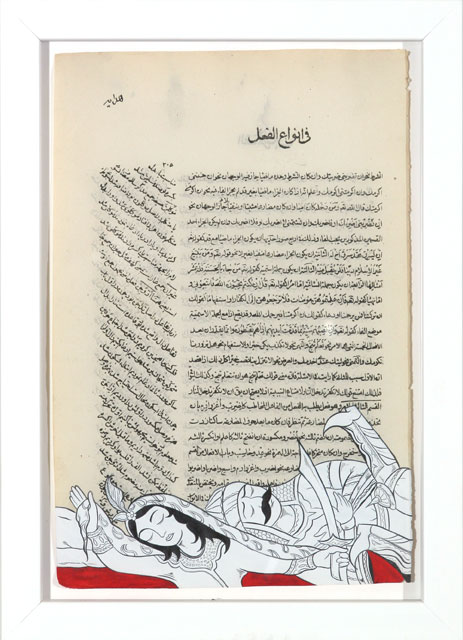
Painting by Ala Ebtekar, Morning Breeze, 2007. Acrylic, ink and opaque watercolor on book page, 10" x 6 3/4"
Fall 2011
Bridging Generations: De Anza Collects
Oct. 24- Dec. 8, 2011
Open Mon.-Thurs. 10 a.m.-3 p.m. during exhibits
Open Saturdays Nov. 5 and Dec. 3 from 10 a.m.-1 p.m. with Family Art Station and Art on Campus Tours.
A re-visioning of the college's Art on Campus Collection, with a look at art and globalization. The exhibition will feature awarding-winning works of art by the De Anza College students from 1971-2011 and a selection of contemporary art, photo and textiles from West Africa. The exhibition is presented in conjunction with the Arts 71 Gallery and Exhibition Design class.
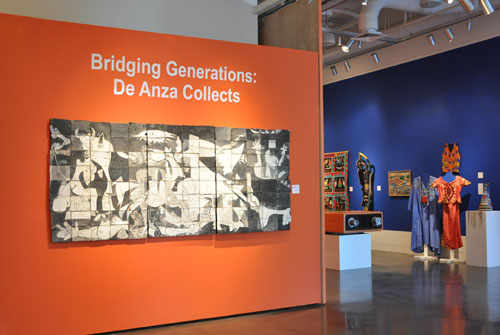
Summer 2011
Come Together For Art
A Special Benefit Auction for the Euphrat Museum of Art
Auction preview exhibition: June 22 and 23 (11-6pm)
FRIDAY JUNE 24, 2011
6pm Reception with hors d’ oeuvres, live music & silent auction
7pm Live Auction
Euphrat Museum of Art at De Anza College
Donation: $30
First of a series of auction/exhibitions. Featuring a recent painting by Paul Hau (Hau Bei Ren), Qin Dynasty artwork (fan paintings, scrolls, and embroideries) from the collection of Connie Young Yu, and art from other accomplished contemporary artists and treasured collections.
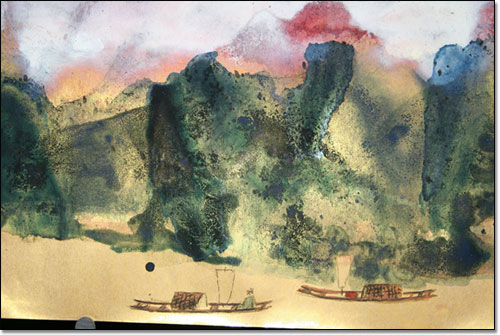
Painting by renowned artist Paul Hau: Colorful Clouds over the River Gorge (detail). Signed and sealed by Hau Pei Jen, dated May 2011 at Old Apricot Villa. 21”x40”. Donated by Paul Hau (Hau Pei Jen) for Euphrat auction.
Sponsors include: Silicon Valley Asian Art Center, Chinese Historical Society of America, American Society for the Advancement of Chinese Art.
Winter/Spring 2011
De Anza College Student Art Show
May 16 - June 14, 2011
Closed Memorial Day, May 30
Open Saturdays June 4 and June 11. From 11 to 3 pm. With special presentations by members from the Museum Studies class and some of the artists in the exhibition.
Reception: Tuesday, June 7, 2011, 5:30-7:30pm. Awards will be presented during this reception.
Check museum hours here.
With wide diversity in media and approach, this exhibition features paintings, drawings, mixed-media works, photography, graphic design, sculpture, ceramics, and more created by students at De Anza College. The exhibition is presented in conjunction with the Gallery and Exhibition Design class.
For more details, visit our Student Shows page.
Come On Down!
Come On Down! is a multi-purpose project space that includes a collaborative communal area for connecting visual and oral history, and an experimental exhibition area for the results of interactive projects. Part of this campus/community space will feature frequently changing artwork. Spring 2011 presentations include:
- High school student activity: Jenny Truong, Nancy Yang. On exhibit is the artwork of two top honorable mentions of Congressman Mike Honda’s Congressional Art Competition. Here is more information about the Competition and the official press release.
An Artistic Discovery is the annual art contest conducted by Members of Congress for high school students across the country. This competition provides Members and the public an opportunity to encourage and recognize the rich artistic talents of young American high school students. The winning artist and 1 guest are flown to Washington, D.C., to attend an unveiling reception held at the Capitol this year. The winning piece from each district is displayed as part of a year-long national exhibition in the Cannon Tunnel, a pedestrian walkway leading from the Cannon House Office Building to the United States Capitol.
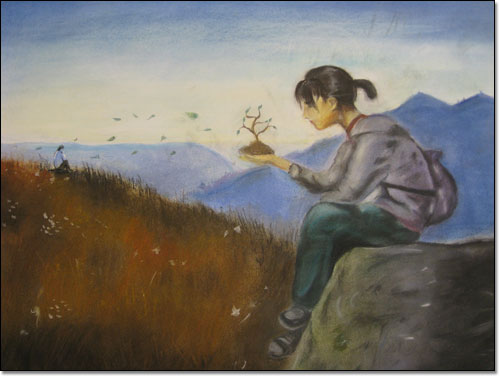
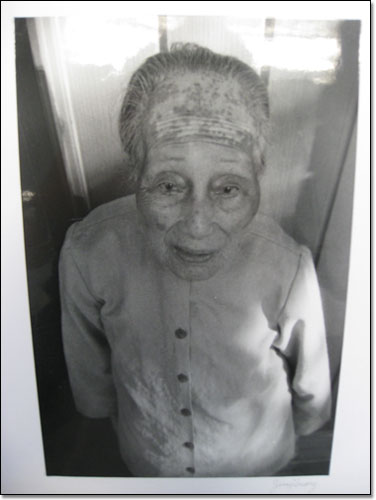
- Artist/student Activity: We are Socially Networked, installation by artist Pantea Karimi and students from Nimitz Elementary School. This installation was connected to Karimi’s Artist of the Year Award, which she received from the Fine Arts Commission, City of Cupertino. Nimitz students (3rd – 5th grade) viewed Karimi’s recent artwork and talked with her about its content. Then the students drew and collaged their own artworks, juxtaposing images of digital technology gadgets, logos, and/or our natural environment. The installation took the form of a social network diagram.
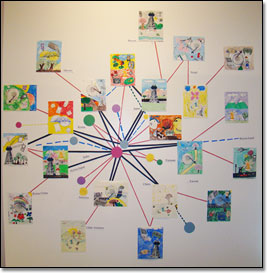
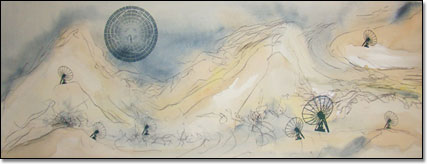
The technologically curious group of students from Nimitz School in Sunnyvale jumped right into the project. Connected with the Euphrat Museum’s acclaimed Arts & Schools Program, this project took the experience of art-making beyond classroom walls, inviting the youth to look at the intersection of art and life in Silicon Valley. Exhibited also are two of Pantea Karimi’s recent artworks. "Through my art, I want to capture moments when technological tools, computer-assisted sounds, programs, and images, simultaneously connect and separate us from one another."
CO-SPONSORS include: Cupertino Fine Arts Commission, City of Cupertino, Euphrat Museum of Art, Arts Council Silicon Valley.
Spring 2011
De Anza and Foothill Art Faculty/Staff Exhibition
March 10 - April 19, 2011
Closed Spring Break, March 28 - April 1
Reception with the artists: April 12, 5:30-7:30pm
The De Anza and Foothill College Art Faculty/Staff Exhibition presents a variety of artwork created by full-time and part-time art faculty and staff from De Anza College in Cupertino and Foothill College in Los Altos Hills. Sculpture, painting, drawing, prints, mixed media, photography, ceramics, and more will be on display.
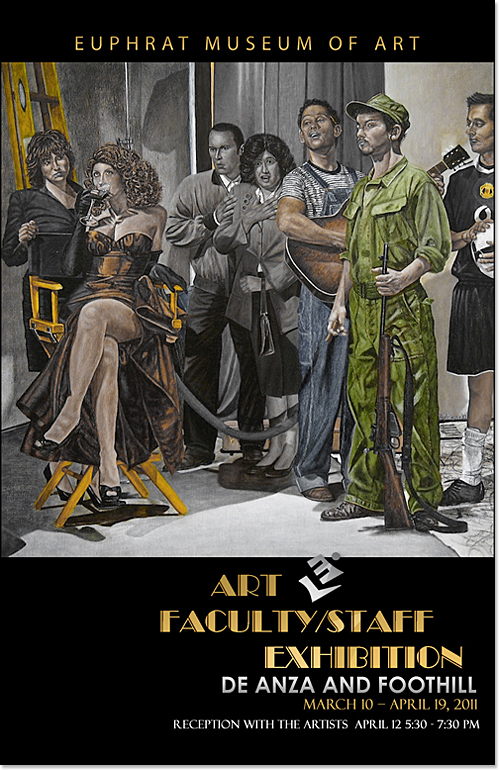
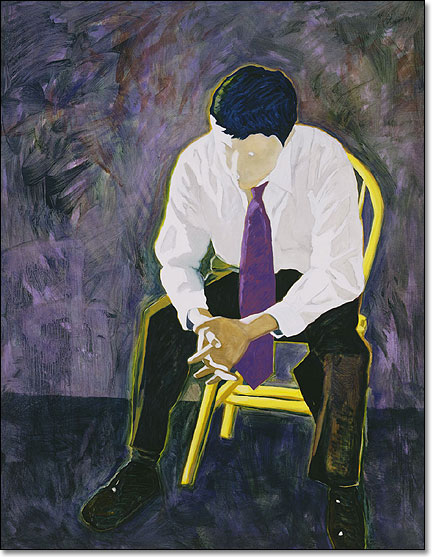
Barbara Allie, Thoughtful Dilemma, 2004. Oil on canvas, 60"x48".
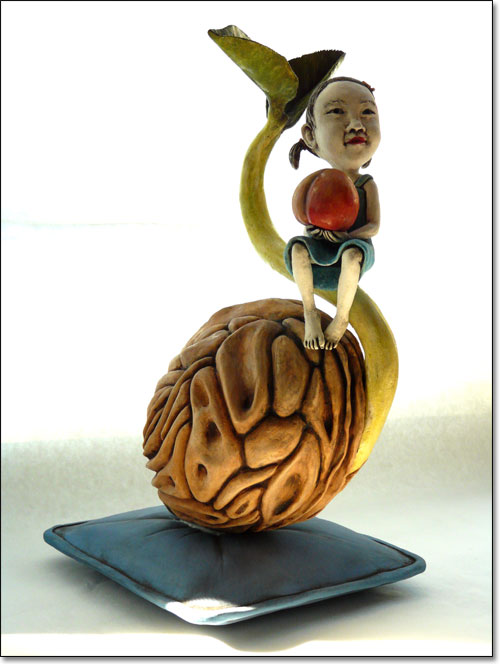
Hsiu-Ling Hwang, Perpetuating, 2011. Clay, stoneware, 16" x 8.5" x 9".
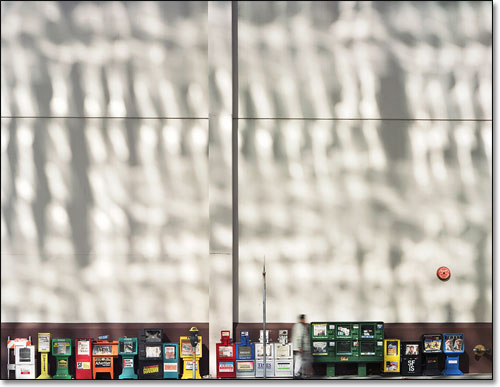
Moshe Quinn, San Francisco #75 (Projection), 2007. Archival print, 39"x50".
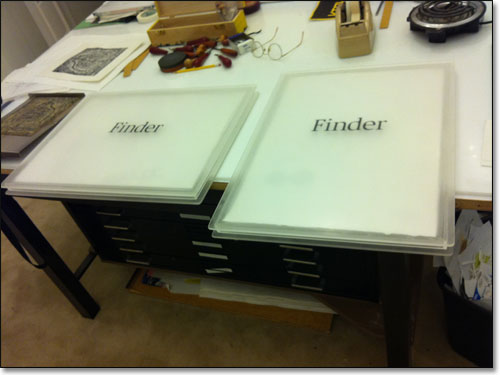
Kent Manske, Finder: Two, 2010. Pigment printing, screen-printing, and Plexiglas, 24.25" x 18.25" x 1.25".
Also Finder: Three, 2010.
Unveiling of "made in usa: Paul Fong"
Friday, March 11, 5-7pm
The Euphrat Museum of Art will host the unveiling of made in usa: Paul Fong 2010, created by award-winning Sunnyvale-based contemporary artist Flo Oy Wong, on Friday, March 11, 2011 from 5pm to 7pm. Donations received that evening will be dedicated to Euphrat Museum community outreach programs.
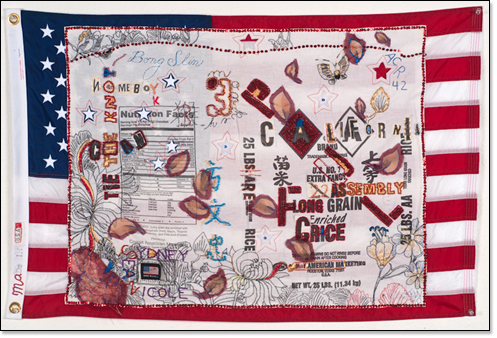
 Visit the Design2Market website for an interactive version of the map! Visit the Design2Market website for an interactive version of the map!
This new work is a continuation of made in usa: Angel Island Shhh, Wong’s seminal installation commissioned by Kearny Street Workshop of San Francisco, of which the organization received a grant from the National Endowment for the Arts. The installation was originally exhibited in 2000 at the Angel Island Immigration Station in collaboration with the Angel Island Immigration Station Foundation, Angel Island Association, and California State Parks. In 2003, the exhibition traveled to the Ellis Island Immigration Museum, New York. A portion of the exhibit was displayed at the Euphrat Museum in 2004.
Flo Oy Wong shared her visual exploration of the detention and interrogation of Chinese immigrants to the U.S. (1910 to 1951) with the nation when she was featured on the PBS NewsHour with Jim Lehrer in 2000. made in usa: Angel Island Shhh originally exhibited a rice sack flag created in honor of Paul Fong’s grandfather, Chan Share, who entered the United States in 1939. Now, ten years later in 2010, Flo Oy Wong has created made in usa: Paul Fong to extend the focus of the original exhibition to include descendants of those celebrated in her primary series. Paul Fong’s election into the California legislature inspired the artist to expand the made in usa series.
The March 11th unveiling ceremony will present made in usa: Paul Fong to the Honorable Assemblyman’s home constituency of the 22nd District. The new artwork celebrates Fong; his wife, Grace Mock Fong; his children; his grandfather, Chan Share; his father, the late Y. K. Fong; and his mother, Mei Fong. Wong’s installation also refers to the family’s history as members of Santa Clara County’s agricultural community—the floral industry. The embroidered floral depiction references a Qing Dynasty textile from the Metropolitan Museum of Art, New York. Another visual reference is ACR42, a significant piece of legislation co-sponsored by the Honorable Assemblyman that apologizes for and recognizes the persecution of Chinese in California for over 150 years due to unjust laws and unfair treatment.
Fong, his family, friends, community members and Flo Oy Wong will be attending the March 11th unveiling ceremony. While the Honorable Assemblyman has won many awards for his leadership, made in usa: Paul Fong is the first artwork that celebrates his family history and his work on behalf of his 22nd Assembly District constituents.
 Please visit this event's Facebook page for more details, and Bob Hsiang's photo album of the event. Please visit this event's Facebook page for more details, and Bob Hsiang's photo album of the event.
 Read the Mercury News and Cupertino Patch review of the event. Read the Mercury News and Cupertino Patch review of the event.
ABOUT THE ARTIST:
Flo Oy Wong, born and raised in Oakland Chinatown, began her career at the age of 40 after taking classes at both De Anza College and Foothill College. She was a founding member of the Sunnyvale Arts Commission and a co-founder of the Asian American Women Artists Association. Wong also served as a member of the board of directors of the Arts Council Silicon Valley and the Euphrat Museum of Art.
The award-winning artist is the recipient of two National Endowment for the Arts Awards. In 2007 she received the City of Sunnyvale’s Art Award and in 2008 she was named an Asian American Hero by Santa Clara County Supervisor Liz Kniss. Wong is also a recipient of the Norman Mineta Lifetime Achievement Award from the Silicon Valley Pacific Asian American Democratic Club.
The artist has shown locally and nationally, and also in Beijing, Hong Kong, Lusaka (Zambia), and Copenhagen. Her work is currently being shown in several traveling shows nation-wide, including Women Call for Peace: Global Vistas. Wong has participated in various artist residencies, including Headlands Center for the Arts and Art Omi in New York. Her works and writings are published in many books, including History as Art, Art as History. She has appeared on the KQED television series, SPARK.
EVENT CO-SPONSOR: Chinese Historical Society of America. We gratefully acknowledge the support of Arts Council Silicon Valley, Asian Americans For Community Involvement, Asian American Women Artists Association, Angel Island Immigration Station Foundation, Asian Pacific American Leadership Institute, Asian Pacific Islander Cultural Center, Chinese Historical Society of America, California History Center, Foothill-De Anza Foundation, and Kearny Street Workshop.
Winter 2011
Learn to Play Too
January 4 – February 24, 2011
Check museum hours here.
EVENTS:
Preview events coinciding with ZER01:
Friday Sept 17, 2010 After work: Game Challenge and Workshop
Saturday Sept 18, 2010: Exhibition (Selected Works)
Saturday 5pm: Deadline for digital submissions
Saturday Evening: Speed judging & awards
Events coinciding with Silicon Valley Fall Festival (Rotary Club of Cupertino, World Journal)
Saturday, Sunday, Sept 25, 26, 2010: 11-4 Exhibition Preview, with
Game Boards Art Station at Memorial Park; Game Spinners Art Station at Euphrat Museum
Hands On Gaming, Part 1
Saturday, October 30, 2010
11am - 1pm: Bike Friendly City Catherine Herdlick
Noon - 2pm: Socks Inc workshop
Noon - 2pm: Game-making workshops
1 pm: Brenda Braithwaite leads her game Train
Hands On Gaming, Part 2
Saturday, November 20, 2010
11am - 1pm: Bike Friendly City Catherine Herdlick
Noon - 2pm: Socks Inc workshop
Noon - 2pm: Game-making workshops
1 pm: Brenda Braithwaite leads her game Train
First Thursday
Thursday, November 4, December 2, 2010, February 3, March 3, 2011, 5-7:30, poetry and more
Hosted by the Black Student Union and Institute of Community and Civic Engagement,
Euphrat Museum of Art
Gameshare
Saturday, February 12, 2011, 1:00pm-3:00pm
Learn to Play Too in conjunction with the San Jose State and Cogswell game development clubs host an afternoon of game design and critique.
April Banks "We Love To Watch"
Monday, February 14, 2011, 9:00am
AT120, Advanced Technology Center, near Euphrat Museum of Art
Brenda Brathwaite "Games Like Photographs: Capturing Emotions"
Wednesday, February 16, 2011, 6:30pm
Forum 1, next to Administration Building in the center of campus
Susana Ruiz "Take Action Games"
Tuesday, February 22, 2011, 9:30am, 10:30am
Admin 109, Administration Building in the center of campus
|
|
ART EXHIBITION:
Artists include Andrew Y Ames, Jim Babb of Socks Inc., April Banks, Brenda Brathwaite, Yunan Cao, Terry Cavanagh, Joe DeLappe, David Elliott, Jake Elliott, Mark Essen, Catherine Herdlick, Rod Humble, Stephen Lavelle, Molleindustria, Francisco Ortega-Grimaldo, Jason Rohrer, Susana Ruiz of Take Action Games, Adam Saltsman, Kelly Santiago and Jenova Chen of thatgamecompany, Jonatan Söderström, Superbrothers, La Mar Williams II, Robert Yang, the City of Cupertino, and more.
Curated by James Morgan and John Bruneau, with Jan Rindfleisch
Partners: ZER01, CADRE Laboratory for New Media
For additional information, visit ZER01's Learn To Play page.
Learn to Play Too, an expansion of the ground-breaking Learn to Play.
Due to the overwhelmingly positive response, and to the great interest from campus and community to develop projects and programming directly related to the exhibition, we offer Learn to Play Too and feature many of the current artists, as well as new ones. Learn To Play Too is incorporating new projects and programming and additional works curated in through various channels: open calls, game challenges, and through our expanding projects, programming, and networking. Our goal is to use the broad topic of games to encourage dialogue, discussion, and engage campus and community, all ages.
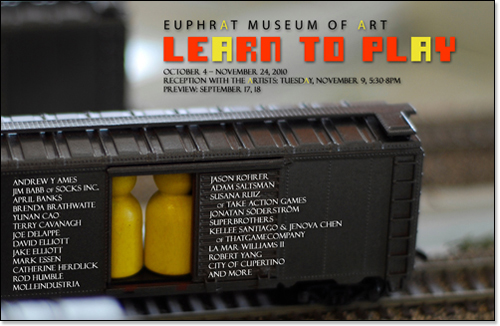
 Read the La Voz Weekly (10/26/2010), La Voz Weekly (2/3/2011), ARTSHIFT San Jose, Spartan Daily, Read the La Voz Weekly (10/26/2010), La Voz Weekly (2/3/2011), ARTSHIFT San Jose, Spartan Daily,
Mercury News, Monta Vista High School's El Estoque, Cupertino Patch, and examiner.com reviews
of this art exhibition.
 Read the La Voz Weekly coverage of the artists' reception. Read the La Voz Weekly coverage of the artists' reception.
 Watch the KCTV 1.9 Taiwanese (Mandarin) channel segment on this art exhibition. Watch the KCTV 1.9 Taiwanese (Mandarin) channel segment on this art exhibition.
When life is a game, how do you learn to play?
Games, an expression of art and life, can bridge the gaps between cultures, and be a common language that brings communities together. Game makers tell compelling stories about their lives or the world. Learn to Play includes video, board and social games by indy game designers. The exhibition offers a selection of poetic, artistic, and artful games that embody the qualities of human existence, focusing on the experience of playing and learning to play. The characteristics of these games echo human nature, teaching us who and what we are, or can be, so we can explore life directions driven by our choice and conscience.
As conduits for bridging or separating cultures, games can be used to bring communities together for improvement of economic and social conditions, or to exploit communities through political maneuvering. The games selected span the range from quick play to epic games requiring many hours to complete; they range from personal growth to those used for socially conscious purposes.
Learn to Play is also a challenge. We invite people of all backgrounds to experience and create games that express social and emotional relevance. During the course of the exhibition, workshops will be held to teach basic game design tools. At the end of the workshops we will have game challenges from which work may be curated into the exhibition.
Come play some games and/or create your own! Below are some examples of games in the exhibition by some of the innovative artists in our show.
Want to try living your life in 5 minutes? Jason Rohrer’s Passage, a short lyrical game, gives you that chance. And then you can repeat and do it again differently. The retro, pixelated 8-bit graphics abstract us from the experience, but also allow us to see ourselves and our lives through our participation in the game. Passage has emotional impact and simplicity. Rohrer is an independent game artist and critic whose games and his work as a whole have bolstered the acceptance of games as a serious art form. For more information, visit his game page.

Start with little yellow game pieces and some boxcars. Brenda Brathwaite’s game, Train, is artful and powerful, drawing one in with its sculptural form, historical reference, and the function of its play. Brathwaite is a game designer, artist and writer who was named one of the top most influential women in the game industry by Gamasutra.com and Next Generation magazine. Her current work is a non-digital gaming collection known as "Mechanic is the Message." Train won a Vanguard Award at IndieCade for "pushing the boundaries of game design and showing us what games can do." New addition to exhibition: Síochán leat (Gaelic for "peace be with you"), aka "The Irish Game," chronicles her family’s history from the Cromwellian invasion of Ireland to their eventual immigration to the West Indies and Canada. A burlap mound, filled with mementos, is covered by 26 pieces of grass, each representing a county in Ireland.
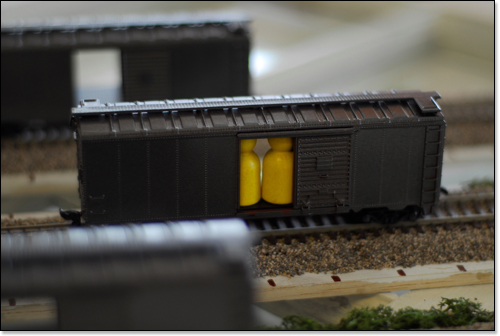
Dive deep. Adam Saltsman’s FATHOM explores the middle ground between life and death. Saltsman, known in the gaming community as Adam Atomic, is an indy game designer and programmer. Saltsman is co-organizer of the Indi Art Jam and responsible for flixel, a popular, open Actionscript library that aids other creators in the development of Flash games.

Catherine Herdlick: "Part scavenger hunt, part guerilla art, and part bike race, Bike Friendly City is a playful urban intervention that arms teams with sidewalk chalk to defend the best bike lanes in Cupertino and make it a bicyclist's paradise with temporary bike boxes and positive messages to their fellow pedal pushers. Play in the bike lanes and explore the streets in ways only an urban biker can appreciate!"
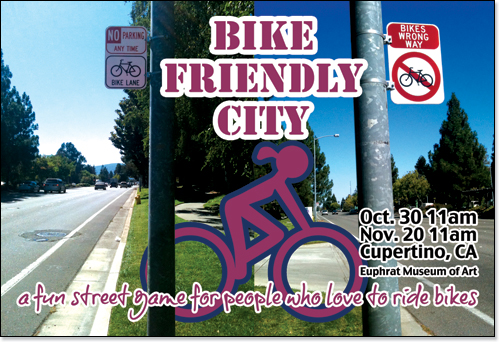
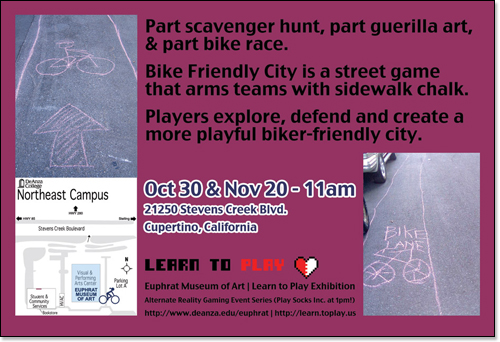
Have fun and play. Yunan Cao’s Ping Pong Diplomacy has an actual fun-to-play ping-pong table painted with the words "trust" and "distrust" in English and Chinese. Cao updates the historical reference to opening up relations between the U.S. and China in the 1970s. "Friendship first, competition second." Her ping pong paddles have faces of US/China diplomacy today. In the Euphrat we extend the invitation of diplomacy to open positive dialog between visitors from different countries, companies, political parties, and more. Also viewers may suggest high-profile match ups to play the game or come up with their own rules.
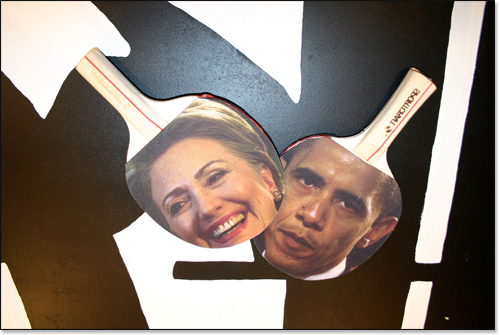
Check out You Meet The Nicest People Making Videogames, the start of an ongoing video project by La Mar Williams II. Williams captures the drive, creative energy, behind gamers, including Anna Anthropy, a woman in an indy games field heavily dominated by men. For more information, visit his Tumblr page. Williams will also run a related workshop for at-risk youth to let them experience the power of making their own game, telling their own story. For more information, visit the workshop's webpage.

Contemplate the game piece. Milk Bath is a photograph from the provocative series We Love to Watch by conceptual artist April Banks with DeQawn Mobley, a former collegiate and NFL player. Mobley is shown putting on his gear amid stereotypic symbols of milk and watermelon. The photo calls attention to the commodified image of the hyper-masculine black athletic body as violent and sexual — a ubiquitous "game piece," putting on his game face. Using the historically racially charged symbol of the watermelon, this work explores Mobley’s experience as a collegiate and NFL player and its well-debated parallels to the slave trade. Going beyond a first-person narrative, Banks and Mobley explore what it means to be reduced to a game time object on the field, watched and "loved" by millions. For more information, visit www.aprilbanks.com.
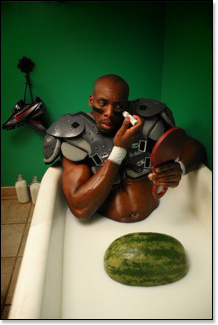
Joe DeLappe reminds us of the cost of our predilection for war with his ongoing memorial series Dead in Iraq. The exhibition features a scale model of a fallen soldier ripped from the video game America’s Army, which is also used as a recruitment tool. As viewers maneuver around the body, one is reminded of the real-life results of warring.
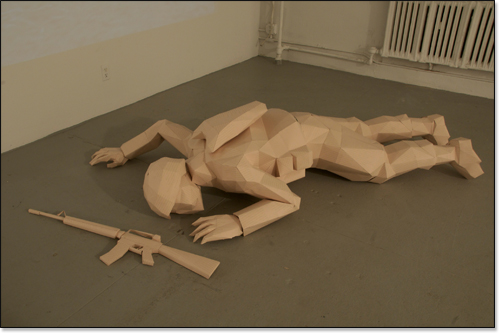
Joseph DeLappe, America’s Army, 2009. Mixed papercraft sculpture made from extracted avatar 3D data.
Photo: Christine A. Butler
Help find Zoe. Susana Ruiz and Take Action Games (TAG) worked with Toronto’s METRAC (Metropolitan Action Committee on Violence Against Women and Children) to create Finding Zoe. METRAC was interested in a game for youth, ages 8-14, addressing abusive dating relationships and gender stereotyping. The game can be played individually or in small groups, ideally facilitated. TAG specializes in casual games for change, addressing social/political content, traversing the intersections of computational art, narrative, journalism, activism, ethics, history and documentary. New: Dying in Darfur, an online game designed to serve as an informational entryway to the current humanitarian crisis in the Sudan. The core TAG team met while graduate students at the University of Southern California’s Interactive Media Division. For more information, visit www.takeactiongames.com.
Take Action Games: Interview with Co-Founder Susana Ruiz
Video by Fernando Julian Perez
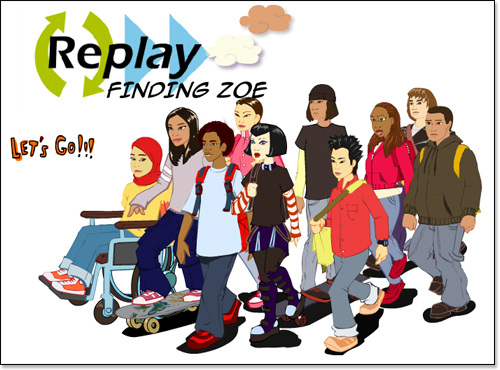
Grab a flower petal and get to know thatgamecompany, founded by Kellee Santiago and Jenova Chen. Flower, a game for PlayStation3, explores emotional chords uncommon in video games. The surrounding environment is the primary "character," posing challenges. Players accumulate flower petals as the onscreen world swings between the pastoral and the chaotic. Everything you pick up causes the environment to change. The player controls the lead petal and accumulates a swarm of flower petals as s/he moves. Thatgamecompany focuses on games that touch and inspire. Chen and Santiago are also graduates of the USC’s Interactive Media MFA program. For more information, visit the game page.
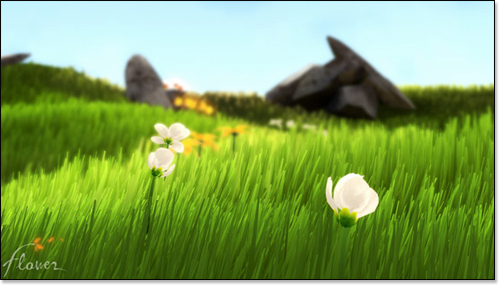
Superbrothers exhibit pixelated game-inspired film shorts. Children of the Clone (with Jim Guthrie). Design Reboot HD (with Jonathan Blow). Dot Matrix Revolution (with Jim Guthrie) has two computer engineers in a captivating dance-off that plays on the development of information technology and the Internet in the last 60 years. For more information, visit the game page.
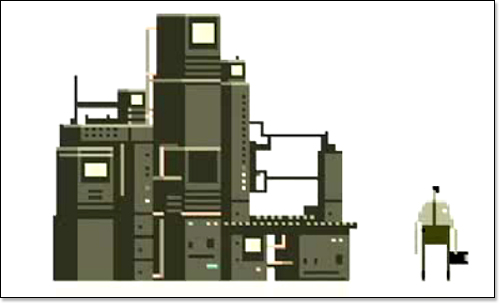
Trouble with your job? Molleindustria’s Everyday the same dream, you are late for work is a "short existential about alienation and refusal of labor. Or if you prefer, a musical video."
Molleindutria, an Italian team of artists, designers, and programmers, likes to subvert the mainstream video gaming cliché and have fun in the process. For more information, visit www.molleindustria.org.

Forget the budget crisis? Balance or Bust Board Game. Your "City Council Team" must decrease spending (or increase revenue) by $2,000,000 by the end of the fiscal year (one trip around the board equals one fiscal year). Select a "Mayor" and "City Clerk." Cards are for services to be cut. Landing on dark pink squares means a Grant Opportunity. Dark green squares are Economic Development Opps. Black squares are bad news… Developed by the City of Cupertino, this award winning game tackles the real thing.
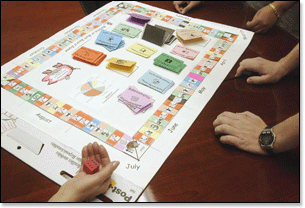
Tell a story. Socks Incorporated by Jim Babb is about creating an avatar, a sock puppet, and telling a story together. The player follows the main character’s narrative while simultaneously participating in his/her own. The sock puppet avatar (a character brought to life by your hand) allows the player to experience real-world play without the fear of embarrassment or the limits of social conformities. Anyone who can upload images and videos can play. The potential for personal expression and creativity is sky-high (or knee-high in the case of socks). You can play it, and then tell all your friends to play it, too. This will create a huge sock-puppet community that will share and comment on stories.
For more information, visit the game page.
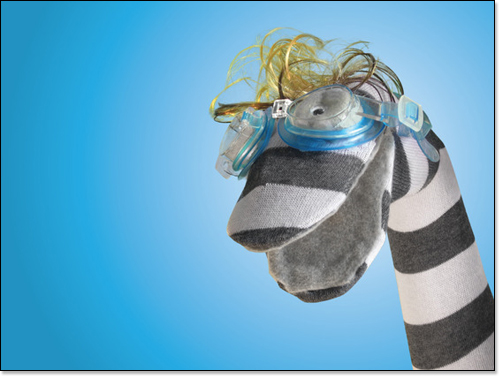
For Corporate Ladder you stack blocks. The object of the board game, developed by David Elliott, UCLA Design Media Arts, is to take up the most space. Players can build up their territory or take over an opponent’s territory, but if you knock over a tower you loose the game. Tall towers become a liability to everyone. Building structures is fun. Deeper pleasure comes when two or more players construction plans intersect. The game transforms from individual expression to social interaction. With conflict and reconciliation, personalities become as much a deciding factor as building strategies. For more information, visit the game page.
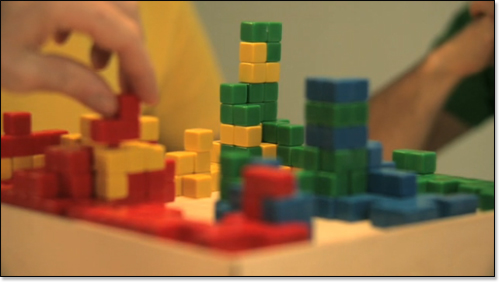
Divorce drama? Robert Yang makes mods. Radiator 1-2, Handle With Care: You’re struggling to repress stressful memories while your worthless husband moans and whines to that equally worthless marriage counselor. (Issue 2, July 2009) A mod(ification) for Half-Life 2 to talk about gay marriage and divorce. For more information, visit www.radiator.debacle.us.
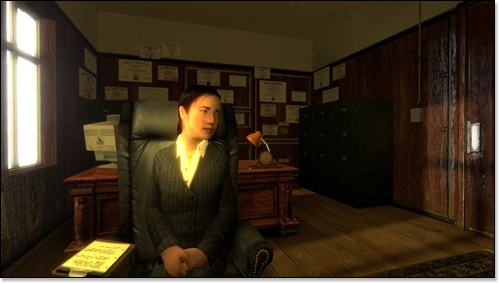
A chess mod to better reflect modern warfare? Andrew Y Ames’s Last Resort is modified chess: war to protect civilians and territory. The Bleached side with pawns, rooks, knights, bishops, and a nuke, fights to free a foreign people in another land; the Oiled side with pawns, fights to be a free people in their own land. Both sides seek to protect life and freedom. The asymmetry of war is encoded in movements. The game has brass civilian pieces that either player may move. Oiled pawns and the nuke may be detonated, removing adjacent pieces. The first player to move four civilians to the row closest to their side wins. The key to winning is through the people caught in the middle. Players can play justly and protect the citizens. Or manipulate civilian loses to gain support through deception. For more information, visit the game page.
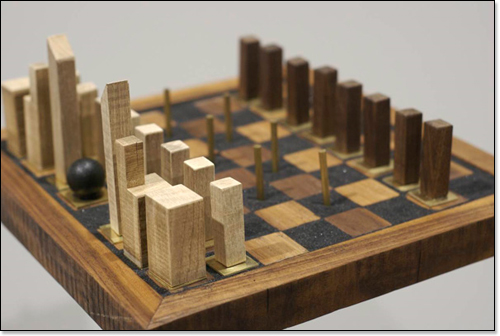
Border Patrol officers search your cargo. Francisco Ortega-Grimaldo's board game Crossing the Bridge “illustrates the symbiotic relationship of the El Paso-Juarez border by resembling the cliché of the illegal exchange of goods between both cities.” Ortega-Grimaldo creates games based on the political frontier between México and the United States, to promote “interest among players about the reality of the border.” See his website Ludoztli (means making games). He is Assistant Professor in Communication Design at Texas Tech and part of the first generation (2000) of SWEAT, a collaborative dedicated to making socially conscious video games.
Jake Elliott. Two grandmothers and two great-grandmothers enliven A House in California, a narrative game. Players engage with "environments and activities drawn from a combination of memory, research, poetry, and fantasy." A House in California inverts the murder mystery game Mystery House (1980) into "a peaceful but surreal character study which draws the player into the inner lives of its characters through verbs like remember, learn and play." View the early trailer.
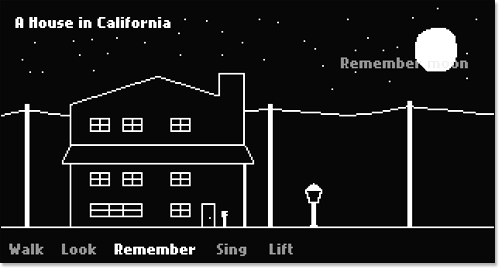
Games with games. Mark Essen, ArtCat Zine interview: "I usually start with a movement and I build environments around that. For You Found the Grappling Hook, a friend sent me this code for a grappling hook, and I built a little engine so you could walk and swing... Eventually, I realized that that was all I wanted to do, so I built some caves, and that was it." After the Businessweek episode, the game morphed into the infamous You Found the Grappling Hook (Pro)…
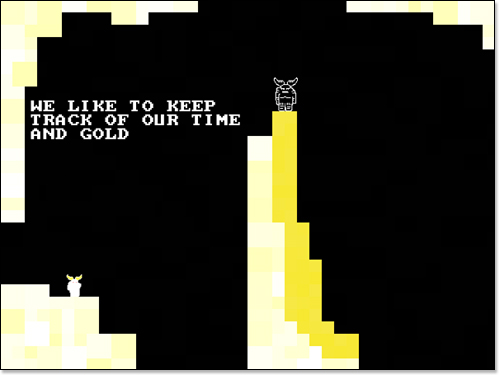
New: upgraded 1/11. For his visual puzzle game Tuning, Jonatan Söderström (Cactus) received the inaugural Nuovo Award, honoring "abstract, shortform, and unconventional game development which advances the medium..." Brandon Boyer, Boing Boing: "when I debuted his last game, Tuning… I continued to field questions about ‘that ball game’ for the rest of the week. Tuning, which went on to take the Sublime Experience award at Indiecade, …is a game about rolling a ball from point A to point B, but embellished by a series of filters that truly test your brain's ability to process inputs."
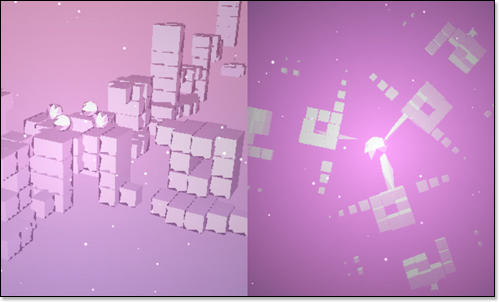
Terry Cavanagh and Stephen Lavelle’s Judith. Cavanagh: "…a game about control." Emily Short, GameSetWatch column: "…navigate through an abandoned castle, each time entering… doors… the player transitions back and forth, playing now a man in the modern day and now a woman some decades (or perhaps centuries) earlier. …the player is afraid of what will happen to the characters, but the only way to see the end of the story is to place them at risk… The protagonists...stand apart from the player: we are risking them… when we choose to walk/have them walk into the darkness… The act of playing through awakens a moral tension in the player."
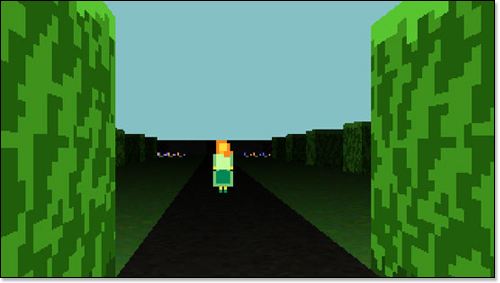
Rod Humble on The Marriage: "I regard game rules as highly compact artistic statements…use game rules to explain something invisible but real… The Marriage came out of a weekend with my wife in Carmel. It was created on my laptop as I listened to the waves... the central point was the Marriage, that if both needs were not satisfied the Marriage dies. …love is satisfying different needs. I need "alone time" and "together time" but not one exclusively and the game’s rules were a way of exploring that. …the power of that initial impact between the two squares and your reaction defines how you look at the rest of the game."
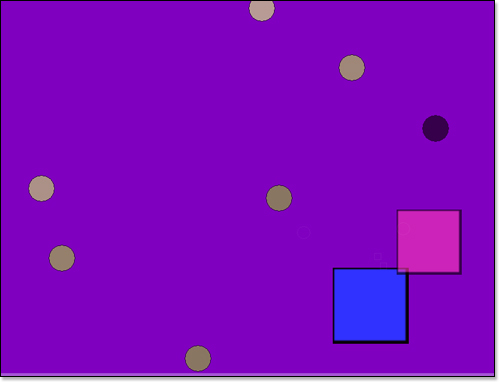
Arcade Murals:
Created on-site for the exhibition, Sean Boyles’s 16-foot mural Control Freak is a tour de force, with line drawings of groups of youth, a bevy of game controls, free-flowing paint, and some nostalgic fowl from Duck Hunt. For more information, visit www.seanboyles.com.
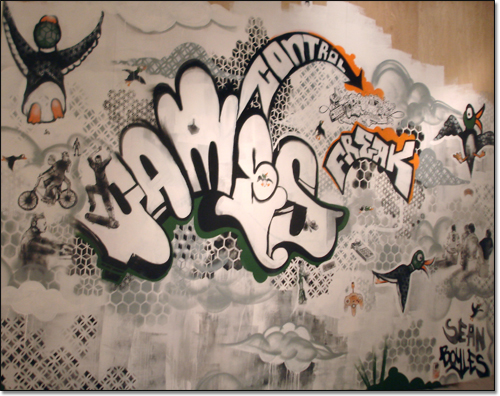
Combining colorful paint and stencils, Rodrigo Oliva’s multi-dimensional Bits brings the museum’s walls, seating, and computers alive with Space Invaders and other early game imagery.
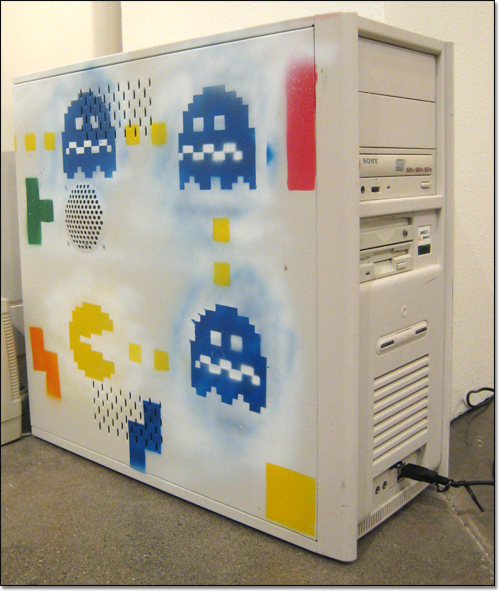
Photo: Janet Leong Malan
Come On Down!
Come On Down! is a multi-purpose project space that includes a collaborative communal area for connecting visual and oral history, and an experimental exhibition area for the results of interactive projects. Part of this campus/community space will feature frequently changing artwork. Fall 2010 presentations will include:
- Student Activity: Euphrat Multidisciplinary Arts Summer Bridge Project for Foster Youth. Santa Clara County high school students in the De Anza College Summer Bridge Program for Foster Youth (developed and directed by Donna Fung) worked with Euphrat staff, looked at goals and resources, and created powerful photographs, a Game mural, and poetry.
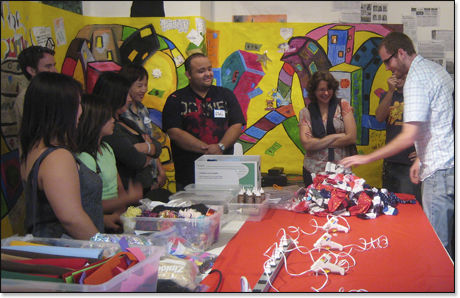
Socks workshop in front of Game of Life mural by foster youth in Euphrat's Multidisciplinary Arts Summer Bridge Project.
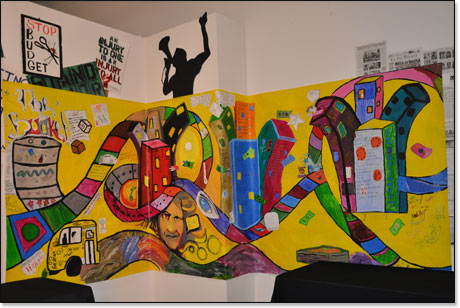
Game of Life mural, part of Art from Euphrat Multidisciplinary Arts Summer Bridge Program for Foster Youth. Juxtaposed with DARE (De Anza Restoring Education) Student Activist Art Show, Sept. 2010 - Feb. 2011. Photograph by Jennifer Dirking
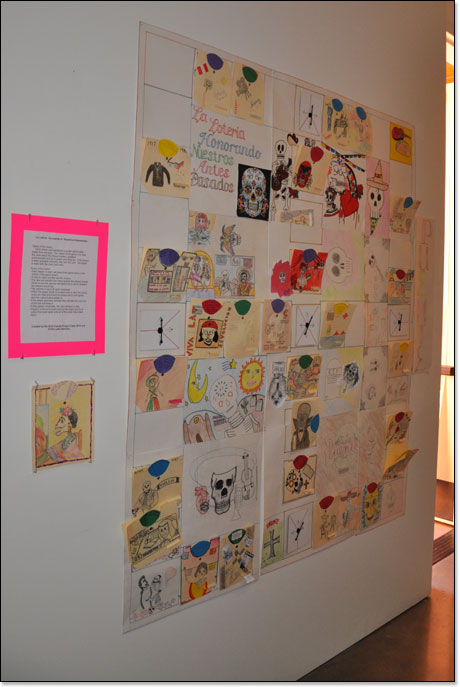
La Loteria game, Honoring Our Ancestors, Honorando a Nuestros Antepasados, collaborative game created by Alicia Cortez's Puente students working in conjunction with Learn to Play exhibition. Each loteria card represents a great Latino/a leader from the past. The object is to read the clues about the chosen leader's accomplishments, guess who they are, and win the card. Nov. 2010 - February 2011. Photograph by Jennifer Dirking
- Also Dia de Los Muertos (Day of the Dead) collaborative altar by MEChA students. November 2010.
- Game-making work stations for workshops, including those conducted by SJSU Game Developers Club.
Winter 2010
In Between: The Tension and Attraction of Difference
Exhibition evolves with Special Projects through April 15th
ART EXHIBITION:
The Euphrat Museum of Art at De Anza College serves a culturally diverse, technologically sophisticated, urban community undergoing rapid economic and social changes. Our inaugural year exhibitions have woven together the stories of artists and groups with local and global connections in an effort to understand the fascinating community that we are situated in: Silicon Valley. Our second major inaugural exhibition, In Between: The Tension and Attraction of Difference, continues our examination of Silicon Valley’s varied and colorful growth through visual media and shared narratives.
Artists include: Marlene Angeja, Mei-chu Chang, Sam Hernandez, Bu Hua, Ken Lo, Abraham Menor, Minette Lee Mangahas, Penny Nii, Ricardo Richey, Lucy Sargeant, Imin Yeh, Xudong Yu, and more.
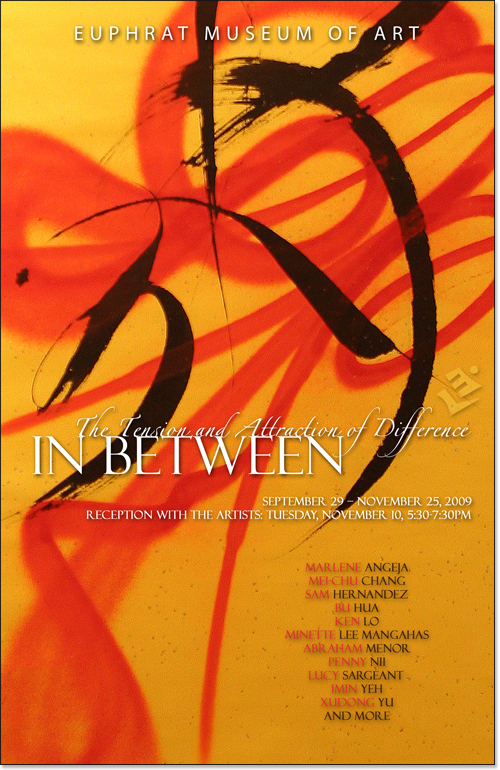
In Between is a gathering of artists who do or see things in a fresh way, who investigate and rethink the status quo, upset common perceptions, embrace the unknown, and change the game. It is language-oriented, yet not
confined by language. Age-old tradition is combined with street art, technology, animation, music, etc. In Between brings together people from different generations and cultures, working with different aspects of the community, stretching across boundaries. This outreach is nourished in the constantly re-inventive Silicon Valley and in the vibrant Bay Area, where tradition and new ideas abound.
Front View
"Much of my work is about MOVEMENT and the tension and attraction of difference. It’s about the freedom that can come from embracing what is born in-between, what we do not know, and sometimes what we fear."
The recent art of Hawaiian-born Minette Lee Mangahas bridges many different cultures. After years studying Zen calligraphy, she began a project working with graffiti artists from around the country. Called Calligraffiti, it opens the door to the many connections that draw from one’s expertise/experiences and pull in the expertise/experience of others. In her Exquisite Corpse series, Mangahas worked with eight graffiti artists individually. Based on a collaborative game invented by the Surrealists, the images are collectively assembled, with each collaborator adding to the composition in sequence. The artists included Amend One, Desi W.O.M.E, and Denz (Oakland), Apex (San Francisco), Coby Kennedy (New York), Lucha (NY + SF), Zen One (Minneapolis), and Toons One (Los Angeles). Mangahas’s own work is like poetry with a brush; she calls it brush-song. Combined with the graffiti artists, a new poetry grows. In one instance, Ricardo Richey (aka Apex) began with the letter "a," created street variations, and then broke into an abstract version as Mangahas responded/interpreted with calligraphy. Ricardo Richey has created a special window painting for Front View. For more information about Mangahas, visit the Headlands Center for the Arts website, and her own website, www.brushsong.com. For more information about Ricardo Richey, visit the luggage store.
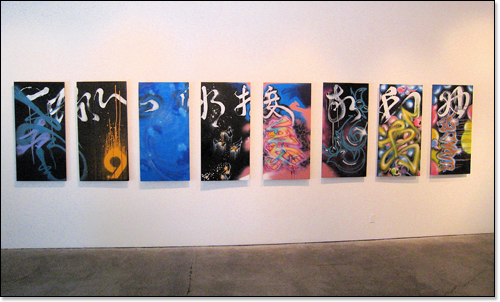
Minette Lee Mangahas with Apex, Coby Kennedy, Zen One, Toons, Amend, Desi
W.O.M.E., Denz, and Lucha, Exquisite Corpse Mural, 2008. Mixed media on wood, eight 2'x4'
panels.
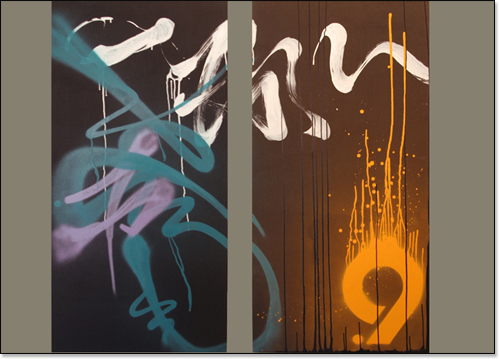
Minette Lee Mangahas with Ricardo Richey and Coby Kennedy, Exquisite Corpse Mural (detail, first two panels), 2008. Mixed media on wood, eight 2'x4' panels.
West Gallery — Poetry and Grammar
Mei-chu Chang is a well-known Chinese calligrapher and seal engraver from Taiwan currently living in the Bay Area. A student of master Bei-Yue Wang, he explored and learned from classic calligraphy. He has been giving calligraphy classes in the Bay Area for ten years. He organized the Antiquarian Club of Chinese Calligraphy while traveling to various U.S. art museums. The Qing Dynasty calligrapher and painter Shi Tao said: "While it takes great efforts to deeply emulate other artists, it takes great courage then to emerge as a unique artist." Beginning in 2008, Chang started a series of breakthrough pieces that encompassed his new experiences. His unique compositions elevate the life of the bold, black brushstroke and place it in a new environment. For more information about Chang, visit the Chinese Culture Center Online Gallery website.
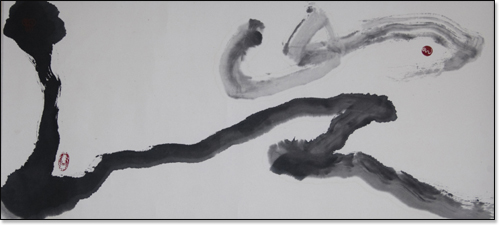
Mei-chu Chang, Landscape, 2008. Ink and seals on rice paper, using Chinese calligraphy brush, 26.5" x 50".
Painter Lucy Sargeant uses brushstrokes differently, with an abundance of color. Brushstrokes and drips freely form the large portrait faces of artist friends, who are often notable San Jose State University professors who have helped shape the Bay Area artistic landscape. Her painting David M. is of sculptor and professor David Middlebrook, who created a major bronze public sculpture on the De Anza campus. Sargeant catches his inner reflection, depicting his unique character traits. Likewise with her portrait of poet and professor Virginia de Araujo. Sargeant’s second career is teaching representational drawing at San Jose State, often to future animators. She finds appeal in de Araujo’s philosophy: "To write a good poem, one has to know grammar." Sargeant builds up form through brushstrokes; then like de Araujo, the artwork takes on a life and poetry of its own. For more information about Sargeant, visit her website, www.lucysargeant.com.
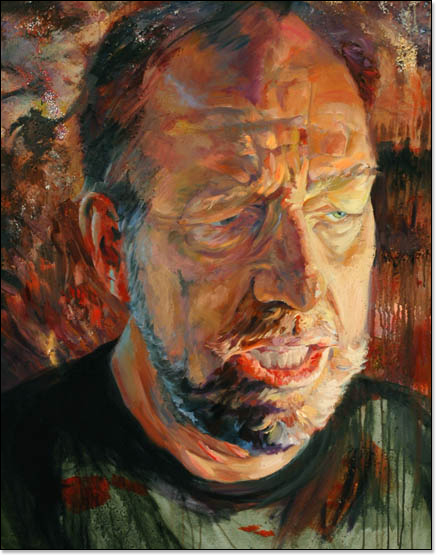
Lucy Sargeant, David M., 1999. Oil on canvas, 48"x36".
Sam Hernandez, longtime professor of sculpture at Santa Clara University, adds an unusual dimension to his customary free-standing sculptures, illuminated by his study of many different cultural traditions. For his large wall piece Dichos y Bichos, he combines a long list of folk wisdom in Spanish. Sprinkled throughout the heavily gessoed lines of text are little bronze critters. This magical piece speaks to all those experiences where we find wisdom on a day-to-day basis. The work is flanked by Homage, a free-standing totemic Chinese scholar-stone work ("awkward stone," Northern style) of redwood, with inlaid pool balls in the base for nodules. Hernandez’s totemic sculptures often have jutting wood elements, like solidified brushstrokes, forming figures or characters for meditative contemplation. For more information about Hernandex, visit his website, www.samhernandezart.com
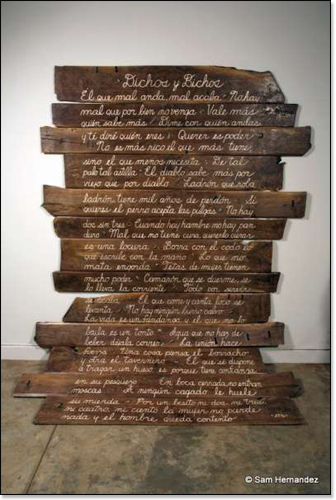
Sam Hernandez, Dichos y Bichos, 2007. Walnut, patinated bronze, gesso, 173"x121"x1.625".
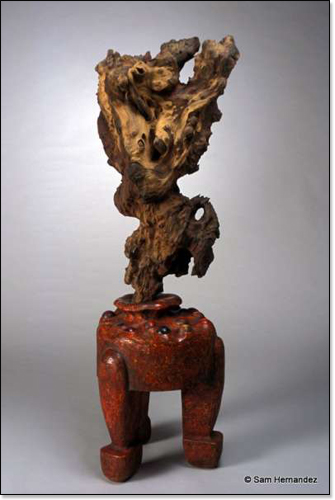
Sam Hernandez, Homage, 2002. Redwood, japan color, pool balls, 63.5"x22.5"x20".
The unusual books of Penny Nii are investigations in form, ideas, and the passage of time. Nii’s expertise has encompassed fabric art, book art, and curating (after a career as research scientist at Stanford University). Her book, Pic to Words, is comprised of pictographs, Chinese/Japanese ideograms, and drawings. It utilizes Gocco prints and a type of accordion/concertina structure. "I have been collecting ancient pictographs and hieroglyphs from Chinese and Japanese sources for many years. The ideograms in use today and the images of the meanings of the ideograms are printed on the left-hand pages. The pages form a wall when opened fully." Yen for Death is in the form of a Japanese funerary urn that opens to create an altar. "The wrapped box … opens into panels that show artifacts related to a short story about the death of my sister-in-law and the aspects of Japanese funerary business. The accordion-folded book, which contains the story, is stored in the lid of the box. The photographs are from my father’s funeral in 1969." For more information about Nii, visit her website, www.penny-nii.com
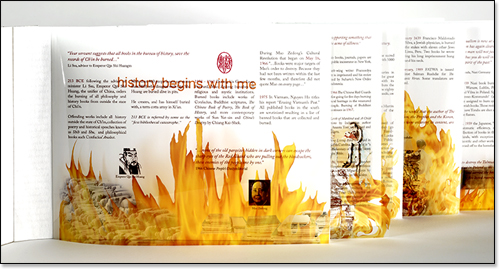
Penny Nii, Ashes, Ashes, We All Fall Down, 2008. Artist book.
Entrada
Imin Yeh’s traditional woodcut prints are a platform to take off to new realms. "Utilizing history, subtle humor, exchange and generosity, social intervention and technical craft," her work opens lively dialog on cultural understanding, playing with subjects such as "good imports" and "student loans." The images range from comforting patterns to Benjamin Franklin to power animals of the zodiac, but with a twist: Year of the Pill Bug, Year of the Three-Toed Sloth, and Urban Street Pigeon, etc. "I am interested in American and Chinese history and in the many ways both cultures and economies are entangled today." While this interest encompasses the function of souvenirs in cultural tourism, cultural fetishism, divisions of labor that result from global industry, and more, Yeh’s playfulness and spirit enliven the unusual projects. Come and participate. Make your own folk festival. For more information about Yeh, visit her website, www.iminyeh.com
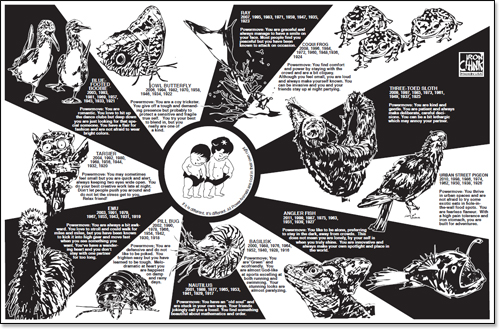
Imin Yeh, Poweranimal Placemats, 2009. Paper placemats, 10"x14".
South Gallery — Double Nature Multi-Faced
Marlene Angeja exhibits several abstract paintings, bold in color and brushstroke. Titles such as The Wheelbarrow only begin to allude to the process and range of ideas around the paintings. Nearby, videos provide another window. Island is a video project using archival footage (1953-58) of the Azores Islands, which lie in the unstable junction between the North American, Eurasian and African tectonic plates. When Angeja was a child, she lived on the island of Pico. Her mother and her brother took a boat to record the eruption of Capelinhos volcano on an 8mm home movie camera. Today, the video composite is about the idea of island from an emigrant’s point of view, which involves a profound sense of nostalgia (saudade) for the lost landscape. For more information, visit her website, www.marleneangeja.com
"For us, geography is history.
Like mermaids, we have a double nature: we are flesh and stone.
Our bones dive into the ocean."
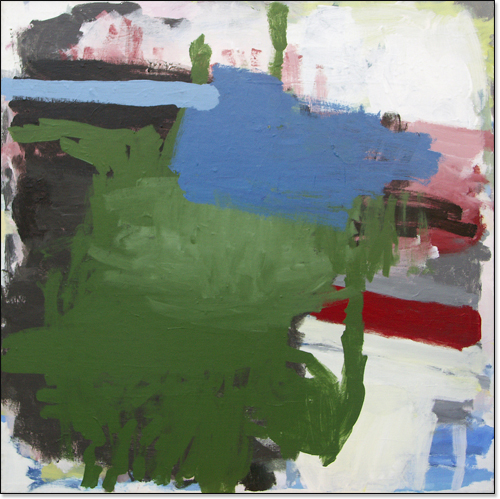
Marlene Angeja, The Wheelbarrow, 2009. Acrylic on canvas, 24"x24".
Bu Hua (Beijing, China) recently exhibited a short animation in San Francisco. Entitled Anxiety, it is about the anxiety that comes from desire and greed, societal status, and about a lone little girl with a wand who with "pure noble thoughts and feelings" goes about saving animals. While Hua’s Shanghai solo show was Man-Made Fairyland, the core of her work is about "the heart." An earlier animation, Oneness, features four figures on a "Journey to the West." Each figure is different, yet sometimes we find their characteristics in the same person. "Everybody is multi-faced." Wordless, the animations speak across continents.
Yu Xudong (Guangzhou, China) exhibits simple signs, all with the letter "a." In One Person’s Parade (his take on China’s parade law), he has photographed himself all alone with a megaphone, determinedly holding his sign high in various safe parts of China — in the middle of an empty warehouse, in the middle of an empty street, standing atop some nondescript low building. In China he can’t protest. For him the rhetorical structure is important and "how the physical and political space in society is being used and consumed." His simple signs, leaning against the museum wall, reference a much larger relationship between the individual and public, whether one is part of the critical dialogue or not even noticed.
Abraham Menor lives in the pulse of San José: Silicon Valley. He is an edgy photographer, an "at-risk" youth case manager, and a community organizer/worker affiliated with Silicon Valley DeBug. With a background in sociology, he began documenting graffiti as a way to examine social behavior. His blog is Brainsoiled. Keepitsoiled — stay grounded. He has documented various social and political movements such as the anti-war movement, the Filipino World War II Veterans Equity Movement, the Silence the Violence Day, and the Martin Luther King Jr. Freedom Train March. The energy he saw on the street greatly influenced his approach to his documentation of Hip Hop culture and street culture. As a participant and observer, Menor captures lived moments, raw and real. He combines his photos with music or alters them with artist Shorty Fatz. He has documented the Shorty Fatz phenomenon from a garage operation to a hot company in the bike world.
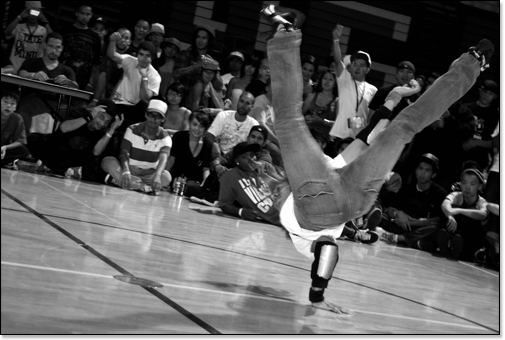
Abraham Menor, The Art Of War, 2009. Digital Print.
Bboys presenting their skills at San José's largest bboy/bgirl event.
Ken Lo, an Asian b-ball legend at 5’7" who ran with Kobe, creates a special installation. K. Lo is a straight shooter: "I’d like to think the quality of your game was all that mattered." So he lays it out: "You are not anyone unless you have a name, and you’re not a name that means anything unless you have a shoe." Through video (The Rice Balla Chronicles), poster, SLAM interview, and an elaborate storefront display (balla cards, radical Chinese paper cutouts and grillwork, Lucky Feet Happy Shoes T shirt, and more), you can check out the man and the all-important shoes. "They used to call me Yellow Fever, because my game was sick. What will they call you?" So if you have a big ego and want to be one of the guys, K. Lo gives good advice: Work versatility into your game. "Don’t just be a shooter….You need to develop a complete game to play." And, "May you always dribble forward and shoot without regret." For reviews of his shoe store, visit Yelp.
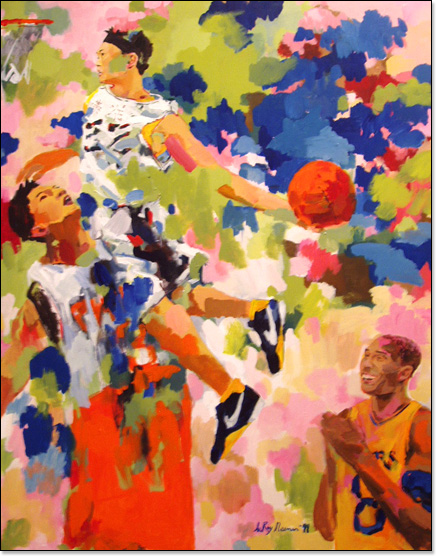
Ken Lo, Leroy Nieman, 2008.
South Gallery Additions (April 5-15)
The Special Projects area in the South Gallery connects artists, college, and community to address the current education crisis in California. Topics range from our formal educational system, to the everyday wisdom that is passed down from our elders and grows anew in the thoughts and ideas of our youth, to the ways in which college and community intersect through programs and projects.
Euphrat Community Arts Mentorship Initiative (2009-10): Working with At-Risk Youth
This Initiative engages college and community through Euphrat exhibition programming, bringing together consultants such as photographer/educator/activist Abe Menor and visual artists/arts educators Lydia Sanchez and Corinne Okada, working with De Anza student interns. Projects were based on the exhibition In Between/ The Tension and Attraction of Difference.
Artists: Abe Menor, Corinne Okada, Lydia Sanchez, students from Columbia Middle School and Nimitz Elementary School, with Edith Argabrite
Abe Menor’s photographs and Corinne Okada’s textiles honor the elders and the history of our community, from Filipino WWII veterans, to Chinese, Japanese, and Mexican agricultural workers, to youth activists today who want healing, unity, and "schools not prisons." Lydia Sanchez’s paintings of marathons in which she has participated show people on the move for change. Okada’s digital textiles depict symbols that "honor the Valley’s agricultural past and celebrate the blending of ethnic groups today and the digital economy driving it."
Edith Argabrite’s multiple yet unique felted yarn Nests speak to the foundation we are providing for future generations, young and old. Nests asks: What kind of educational and community institutions are we building for lifelong nurturing and learning?
Students from Columbia Middle School exhibit Falling and Flying books, inspired by Penny Nii’s artist books, with the goal of passing on their personal life struggles and accomplishments to younger students.
Students from Nimitz Elementary School exhibit several projects: Dichos y Bichos, based on the Sam Hernandez sculpture of the same name, reflect cultural sayings/wisdom passed down in the family and community. What You Don’t Know About Me, using words and photographic portraits, and involving speaking up and teamwork. In Zodiac Trading Cards, based on Imin Yeh’s reinvented zodiac animals, students identified one of their strengths and also weaknesses.
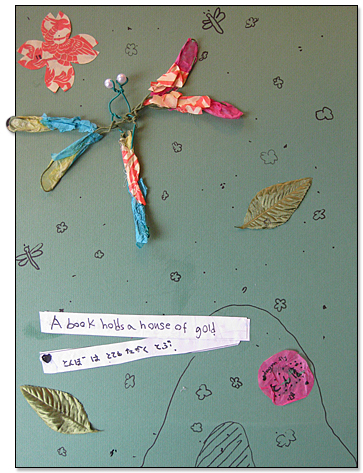
Hanako. Nimitz Elementary School. Dichos y Bichos project.
Come On Down!
Come On Down! is a multi-purpose project space that includes a collaborative communal area for connecting visual and oral history, and an experimental exhibition area for the results of interactive projects. Part of this campus/community space will feature frequently changing artwork. Presentations include:
- Student Activity: Santa Clara County high school students in the Summer Bridge Program for foster youth (developed by Donna Fung) at De Anza created (Super)heroes. Working with Euphrat staff, they examined qualities of heroism in their own lives and in the lives of those around them. They built powerful mixed-media art pieces, using words, poetry, images, paint, and sections of recycled doors.
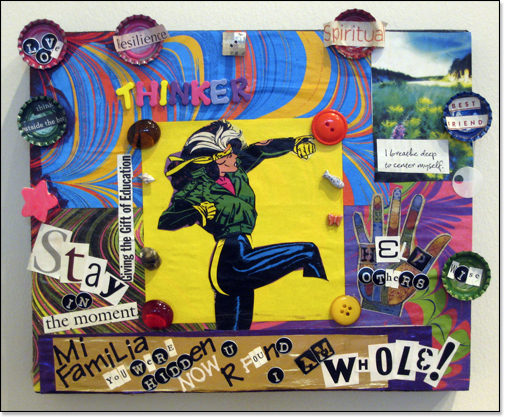
Santa Clara County high school student, (Super)hero project, 2009. Part of the Euphrat Museum Art Project in conjunction with the Summer Bridge Program for foster youth.
- Publications: This area is also used for study and research. Several publications are on display, including Present Tense and The Fourth R: Art and the Needs of Children and Youth.
- El Dia de Los Muertos (Day of the Dead) shoe-box ofrendas and display by Puente students. Students created individual altars honoring people they know or addressing a community issue. They helped design the installation, which included Mexican textiles, papel picado, a portrait of Cesar Chavez, and a hand-painted canvas banner by Francisco Garcia. Alicia Cortez, Puente Project Co-Coordinator, Counselor/Instructor. November 2009 only.
- Culture Jamming Subvertisements: Sal Breiter’s winter Popular Culture class created Subvertisements. Selected artworks were installed first for critique, with suggestions in a notebook. The "subvert" has the look and feel of the targeted ad, with the same high production quality, but it promotes a classic double-take from viewers as they realize they have been duped. This creates cognitive dissonance and reveals a deeper truth within. Culture Jamming is a process of transforming mass media to produce commentary about itself. It is a form of public activism, creating a contrast between mass media images and the realities and negative sides of the corporation or media. Photographs of the subvertisements in the community will be included.
- The Mapping Project: Purba Fernandez’s Geography 1 class took the lead on this ongoing collaborative project and interactive installation, which connects stories and images of Silicon Valley. Students and viewers describe a location in Silicon Valley where something personally meaningful happened, e.g. a memorable place as a child or how a place changed with new development.
Collaborators: The California History Center, Geography Department, Euphrat Museum of Art.
Come On Down! Project Space Additions (March, April)
At our Come On Down! project space, we are showing two projects from Sal Breiter’s Popular Culture class at De Anza:
- Culture Jamming Subvertisement "roughs" and two finished Subvertisements, including one by iSPEAK. The "subvert" has the look and feel of the targeted ad, with the same high production quality, to promote a classic double-take from viewers as they realize they have been duped. Culture Jamming a form of public activism, creating a contrast between mass media images and the realities and negative sides of the corporation or media.
- "The Pen is Mightier Than the Sword" Project and Sticker Project. Students identified "words" and phrases from constructive-feedback letters they had written to producers of popular culture and used them as a foundation for their sticker project. Using artist Tucker Nichols as an inspiration, students took photographs of their temporary removable stickers that they placed around their communities.
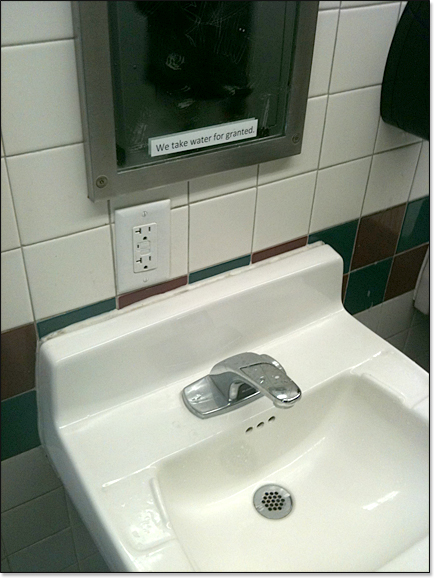
Sticker Project.
The exhibition was curated by Jan Rindfleisch, along with the artists and with Nancy Hom, Abby Chen, Robin Treen, Jianhua Shu, and others.
Works by Bu Hua, Ken Lo, Imin Yeh, and Yu Xudong were recently shown at the Chinese Culture Center in an exhibition entitled Present Tense: Chinese Character, which reflected a fresh perspective through the eyes of young artists. More information on these artists can be found in the accompanying book of the same name. In addition to its focus on youth, one of the exhibit’s premises was that any of us can be Chinese. In In Between, we expand that concept further by considering the multiple, inventive ways that people employ to probe other identities and to take on new traits and styles that suit their fancies or needs.
Summer 2009
(Super)heroes
Project in July. Private reception. Open by appointment in August.
Select portions of the exhibition will be included in the Euphrat’s fall schedule.
Santa Clara County youth participating in the Summer Bridge Program
The (Super)heroes presented individual art along with poetry and writings by high school students, part of a Euphrat art project in conjunction with the Summer Bridge Program for foster youth. Youth considered what it meant to be a (Super)hero and what heroic qualities they saw in themselves or those around them. The mixed media art with images and text were powerful and insightful, directly related to their life experiences. The youth had the opportunity to speak in front of their art and writings at a community reception in the Euphrat and then later at a luncheon in the Campus Center.
Winter 2009
In February 2009, the Euphrat Museum of Art opened
its doors to a
brand new exhibition space.
INAUGURAL ART EXHIBITION:
Looking
Back, Looking Ahead
February 17 - April 24, 2009
Closed Spring Break, March 30 - April 4
Reception with the Artists: Wednesday, March 11, 5:30-7:30pm.
 Read a review of this inaugural art exhibition. Read a review of this inaugural art exhibition.
The Euphrat Museum of Art at De Anza College serves a culturally
diverse, technologically sophisticated, urban community undergoing
rapid economic and social changes. Looking
Back, Looking Ahead is an eclectic look at Silicon
Valley’s varied and colorful growth through visual media and
shared narratives. This inaugural exhibition honors our past
and looks to the future as we weave together the stories of
artists and the stories of Silicon Valley residents and groups
in an effort to understand the fascinating community that we
are situated in. This is Silicon Valley. This is our story,
your story.
Artists include: Paul Pei-Jen
Hau, Agnes Pelton, Thai Bui, Rene Yung, Angela Buenning Filo,
Consuelo Jimenez Underwood, Charisse Domingo, Mike Arcega, Shorty
Fatz, Samuel Rodriguez, Matthew Rodriguez, and more.
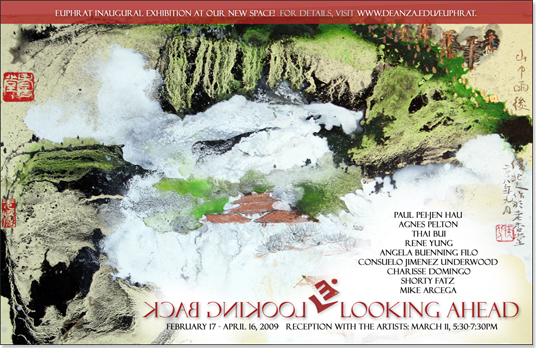
West Gallery
— Mountain Light Stone
Featuring Paul Pei-Jen Hau, Agnes Pelton, Thai Bui
Our honored artist for Looking
Back, Looking Ahead is world-renowned painter Paul
Pei-Jen Hau, who has a museum named after him in eastern
China. Opened in 2002, the Hau Pei-Jen Art Museum contains many
of his artworks and art from his personal collection. Hau’s
bold watercolor and ink paintings bridge cultures of East and
West, with references that range from the Ming dynasty to the
vanguard of Western abstraction. His work has been exhibited
at the San Jose Museum of Art and at the De Young Museum in
San Francisco. Born in 1917 in Liaoning Province, Hau studied
in both China and Japan. In 1956 he moved to California to teach
at the Pacific Art League in Palo Alto. He lives in Los Altos
and has taught locally for over 50 years. He has published three
novels, a history of sociology, and a book on Chinese art. At
age 92, he still visits China. In addition to the exhibit, a
conversation/celebration with the artist is planned to help
students and the community learn more about Hau and his impact
locally and internationally. We hope the presentation will inspire
further local research on Chinese masters in the area.
View a video interview of Paul Pei-Jen Hau by Diana Ding here.
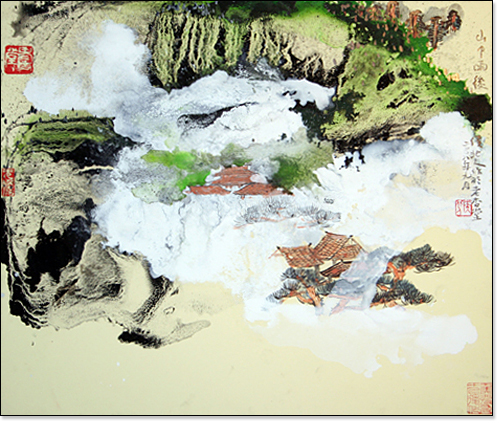
Paul Pei-Jen Hau, The
Mountains After Raining, 2008. Ink and color on paper,
20"x24".
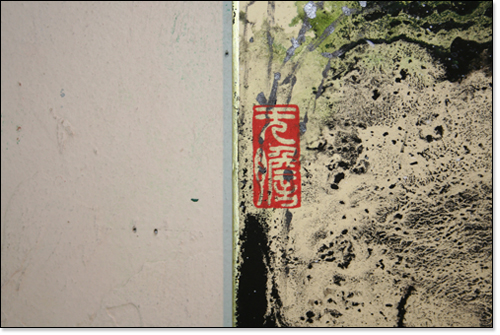
Paul Pei-Jen Hau Seal: The Humble
Old Man
Agnes Pelton (1881-1961)
was born in Stuttgart, Germany. She studied at the Pratt Institute
in New York. In the 1920s she focused on abstraction and joined
with the Transcendental Painting Group. Known as a “Poet of
Nature,” her mystical landscapes, many created after her move
in 1931 to Cathedral City, California, suggest a meditative
world where East meets West and spirit, vision, and nature harmonize.
Not much was known about Agnes Pelton when we researched her
in the early 1980s. Our publication, Staying
Visible (1981), includes a section on her life and work.
In the course of our research, a small collection of Pelton’s
work was acquired. Since then, Pelton has been the subject of
growing scholarship. Today Pelton's art stands alongside American
legend Georgia O'Keeffe's. Pelton's Light Center, owned by the Euphrat,
will be part of the exhibition Illumination: The Paintings of Georgia
O'Keeffe, Agnes Pelton, Agnes Martin, and Florence Pierce, organized
by the Orange County Museum of Art (OCMA). Light Center was shown at
the Euphrat in February and March, after which it is on exhibition
at OCMA. Related publications are available, along with study guides for children.
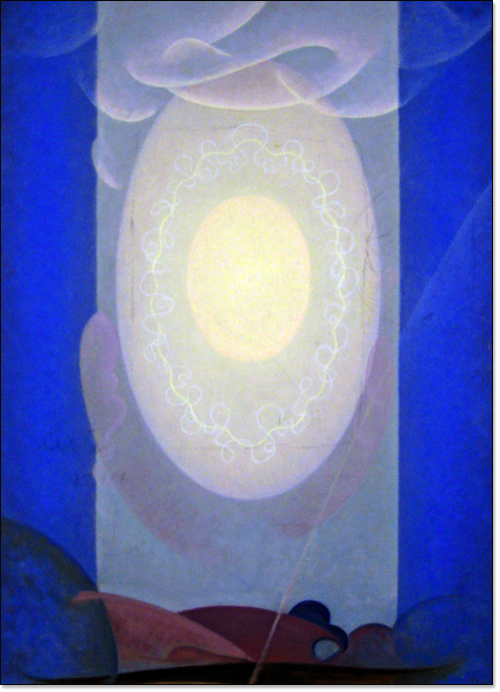
Agnes Pelton, Light
Center, 1960-61. Oil on canvas, 36"x26". Collection of
Euphrat Museum of Art, De Anza College, Cupertino, California.
Gift of Cornelia Sussman and Irving Sussman.
Visually simple and intellectually complex, Thai
Bui’s sculpture connects Eastern philosophies and several
Western art movements: Minimalism, Funk, and Conceptual. Originally
from Vietnam, Bui came to the U.S. in 1981 and received his
MFA from Stanford University in 1992. His series, Needed, a
poetic grouping of stones, not only relates to close personal
relationships but also to our relationship with others and to
nature. The concepts cross multiple boundaries. In Needed,
stones are linked as male/female pairs. For a ceiling installation,
half of each stone pair is suspended in a Haiku form. The other
half is supported by its link. Bui has been profiled on KQED’s
SPARK.
South Gallery
— Story Lines
Everyday stories are tangible in Rene
Yung’s major installation ….anges
and disappearances. A low wall made of 400 bars of soap imprinted
with the word “Remember” sits on a weathered wooden platform. Towels imprinted
with words of personal memories and official identity hang on a nearby clothesline.
A stool and wash basin beckon you to sit down, wash a towel, and hang it up on the
clothesline. With use, the words on the soap and towels fade away, symbolizing the
erasure of the cultural memory of 19th century immigrants, such as the 15,000
Chinese who helped build the Transcontinental Railroad, the Chinese who worked
the mines, and ran laundries when prohibited by law to own land. Their overlooked
stories continue on in today’s immigration debate. We will work with Yung and
others on campus and in the community to capture the histories and stories of
today, and to connect them with our visual life.
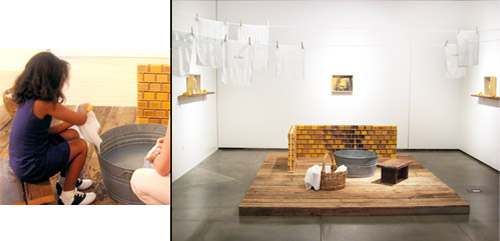
Rene Yung, ...nges
and Disappearances, 2004. Interactive mixed media installation.
Interactive installation with multiple components, dimensions
variable.
Change is rapid in Silicon Valley. Angela
Buenning Filo’s photographs give the sense of news today,
history tomorrow. The images include an electromagnetic emissions
testing site in Mountain View and a dismantled server room in
Sunnyvale. Juxtaposed are her images from Bangalore, India’s
Silicon Valley. Among these are the lobby of a 24-7 customer
service and the entrance to Electronic City. Many of the Silicon
Valley scenes are devoid of people. Her scenes capture the uncertainty
of investment and return as jobs and buildings appear and disappear.
Some of the Bangalore images reflect the stark contrast with
between current technology and everyday life. The high-school
journalism program that Filo teaches in East Palo Alto has won
a national award for its student newspaper, a copy of which
will be on display. Filo will share stories of our Silicon Valley
tech community and youth.
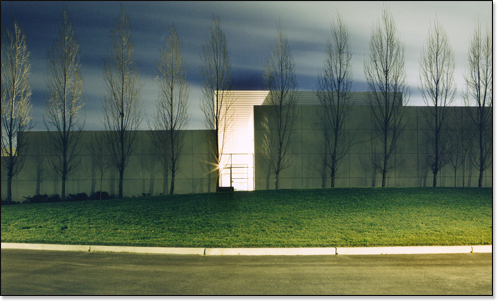
Angela Buenning Filo, Biotechnology
Company Headquarters, Mountain View, 2001. Photograph,
30"x40".
Consuelo Jimenez
Underwood lives in Cupertino. She has been a professor
in textiles at San Jose State for many years. On exhibit will
be a Mexican American flag with the Sunnyvale Libby Fruit Cocktail
can trademark in the center. “My dad was a bracero in WWII.
They never fully paid my dad. They paid Mexico.” Underwood has
many stories to share, including her international travels.
These stories will lay the groundwork for a project that will
be exhibited in the fall. Underwood has been chosen as a video
subject for the American Craft Council.
Silicon Valley De-Bug
uses a variety of media, from magazines to radio to web to sculpture,
to tell stories of Silicon Valley. De-Bug is a collective of
writers, artists, organizers, and workers based in San José.
They are a project of Pacific News Service, a national news
service. On exhibit will be Charisse
Domingo’s portraits of mothers who face family problems
with the criminal justice system, juvenile hall, and deportation.
Domingo is part of the Euphrat's inaugural exhibition Looking Back, Looking Ahead.
She also works with the Open Darkroom sponsored by De-Bug.
De-Bug will give a presentation, and one of the groups affiliated
with De-Bug, Shorty Fatz,
will create a display in the Front View window.
Entrada
Military garment and ceremony get a contemporary makeover with
two works by Mike Arcega.
They have special resonance with De Anza College, which is named
after Juan Bautista de Anza, and with our central location in
Silicon Valley. El Conquistadourke
assumes a pose like a security guardian or a welcoming figure.
This humorous 6’ suit of armor constructed of manila file folders
comments on “the frailty of military might and the strength
of trade.” Arcega mocks a romanticized view of the conquistadores
of old and comments on trade practices today. Close by is Loping
Honoring. Here, technology complicates our communication
and identity and pokes at our pride. For this multi-media work
of video, audio, lyrics, text was generated by spell checking
the national anthem of the Philippines, Lupang Hinirang, in
Microsoft Word V.11.3. This text was then reapplied to the harmony
of Lupang Hinirang and sung in an operatic voice.
Front View
Custom bike specialists Shorty
Fatz will create a special Front View window installation
with their signature bikes. Samuel Rodriguez and Matthew Rodriguez
create bikes unique in style and function. “Our goals are to
create a stylish cruise with comfort and durability.” The ubiquitous
Shorty Fatz cartoon character has a story of its own. Ensconced
in a vinyl showcase window, the custom bike speaks to individual
dreams as well as to stylish transportation. This is one of
Silicon Valley’s new stories – building an art company and reaching
out to youth with graphics and bike workshops. A mini-residency
with the artists is being planned.
Come On Down!
Come On Down! is a multi-purpose project space that includes
a collaborative communal area for connecting visual and oral
history, and an experimental exhibition area for the results
of interactive projects. Part of this space for campus and community
will feature frequently changing artwork. Presentations in this
area for early 2009 will include:
- The Mapping
Project: This pilot collaborative project sparked an interactive installation.
Viewers describe a special place in Silicon Valley where something very significant
happened and connect it to a map. This ongoing project connecting stories and images
of Silicon Valley has both handwritten and Internet components, including a Flickr
site. Collaborators: The California History Center, Geography Department, Euphrat Museum of Art.
- Picturing Our Communities:
Marc Coronado and Karen Chow's ¡LEAD! Winter 2009 EWRT 1A classes presented a large
installation of photographs and a narrative slideshow on computer. Students identified
their communities, took photos and wrote about them, and addressed how immigration impacts
these communities. A select group of students designed and installed the art as part of
a Community Service Learning Project.
- Drawing From History:
Students from Juliana Kang’s Intermediate Drawing class, drawing from Silicon Valley
artifacts and photographs, displayed artwork about local history and change. Community
collaborators include the Cupertino Historical Society and Museum and the Sunnyvale
Historical Museum.
- Art From The X-Ray Project
: Artwork and information from The X-Ray Project, a two-week adjunct exhibition co-sponsored by the Euphrat Museum of Art and taking place concurrently in the De Anza Library. The X-Ray Project is a photography exhibit that uses actual X-Rays and CT scans of terror victims to explore the effects of terrorism on civilian populations worldwide. Co-sponsors included De Anza College Library, Hillel of Silicon Valley, De Anza College Jews, and Israelis & Friends Club.
- Publications
on view included the Euphrat publication, Staying Visible The Importance of Archives (1981), Agnes Pelton: Poet of Nature, and the curriculum developed by the Orange County Museum of Art for studying Agnes Pelton. Also, we have Hau Pei-Jen Art Museum and Connie Young Yu’s Profiles in Excellence, Peninsula Chinese Americans (1986) for studying Paul Pei-Jen Hau.
The inaugural exhibition was curated by Jan Rindfleisch, working
with the artists and with Nancy Hom, Tom Izu, Jianhua Shu, Adrian
Avila and Raj Jayadev and others. Collaborators include Silicon
Valley De-Bug, California History Center, De Anza ¡LEAD! Program,
Creative Arts Division, Intercultural and International Studies
Division, Institute for Community and Civic Engagement, and
more. Program development with Euphrat Advisory Council, Euphrat
Program Committee, and Euphrat staff.
Fall 2008
De Anza and Foothill Art Faculty/Staff Exhibition
September 30 - October 30, 2008
The De Anza and Foothill College Art Faculty/Staff Exhibition presents a variety of artwork created by full-time and part-time art faculty and staff from De Anza College in Cupertino and Foothill College in Los Altos Hills. Sculpture, painting, drawing, prints, mixed media, photography, ceramics, and more will be on display.

Summer 2008
Summer Bridge Program
Pilot project in July. Private reception. Open by appointment in August.
Santa Clara County youth participating in the Summer Bridge Program
The Summer Bridge Program exhibition presented individual and collaborative art along with poetry and writings by high school students, part of a Euphrat pilot project in conjunction with the Summer Bridge Program for foster youth. The students produced art and writings directly related to their life experiences. The youth had the opportunity to speak in front of their art and writings at a community reception in the Euphrat and then later at a luncheon in the Campus Center.
Spring 2008
Graphic Storytelling as Activism
February 11 - April 17, 2008
Closed President's Day, February 18, and spring break, March 31 – April 4
Artists include:
Seyed Alavi, Oliver Chin, Charisse Domingo and De-Bug, Sharon Hing, Keith Knight, Lingshan, America Meredith, Favianna Rodriguez, Shorty Fatz
Graphic Storytelling as Activism presents a variety of art forms, including cartoons, political posters, digital art, book art, and more to explore a range of imagery with an activist bent. It began with graphic storyteller Keith Knight, who sees comics and cartooning as a powerful tool for social change. They have been “communicating information, concepts, and ideas since the days of hieroglyphics. They can transcend language, class, and race. Knowing the tools and concepts of cartooning allows anyone to be a mass communicator… You don’t need a million dollars. Just a pen and a piece of paper.” In this exhibition we took Knight’s ideas a bit farther, adding other tools to enable one to build communities through community-based arts, to address issues of the day, locally and globally, and to tell the personal story with the larger context, historically and culturally.
Graphic storyteller Keith Knight exhibits work from three series. One group of cartoons is from the book Beginner’s Guide to Community-Based Arts, which features ten graphic stories about artists, educators, and activists across the U.S. Knight’s drawings bring alive people and stories, e.g. Lily Yeh, Founder of the Village of Arts and Humanities in Philadelphia, and James “Big Man” Maxton, master mosaicist and former Operations Director at the Village. Other images on display are drawn from his nationally syndicated comic strips, “The K Chronicles” and “(th)ink.” Knight is an award-winning cartoonist, rapper, and hip-hop musician. www.kchronicles.com
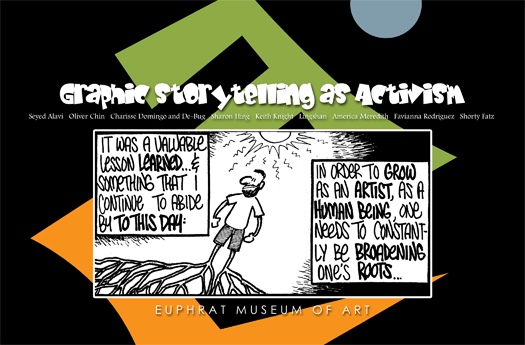
Favianna Rodriguez exhibits colorful silkscreen and other prints, including political posters and personal art. Her silkscreen Designs on Democracy: Communication for Liberation shows the intersection between being a designer and an activist. The image is a self-portrait with a city landscape. “My intersecting identities as a poster artist, activist, designer, and woman of color all came together in this piece.” Rodriguez was schooled in East Oakland by Chicano political-poster artists. “My art pieces reflect national and international grassroots struggles, and tell a history of social justice through graphics.” Rodriguez is a founding member of the EastSide Arts Alliance (ESAA), an Oakland-based collective of third world artists and community organizers. www.favianna.com
Oliver Chin uses comics to educate and promote discussion. Images and words from his graphic novel 9 of 1: A Window to the World deal with perspectives of many people around the time of the terrorist attacks of September 11, 2001. The format is of nine members of an eleventh grade class interviewing various members of their diverse community. Through creative use of drawings and text, he combines history, geography, personal perspectives of interviewer and interviewee, emotion and experience, and ways to learn from the past. Also on exhibit will be references to the Julie Black Belt and The Octonauts books, which he has published. Using contemporary cartooning styles, these books provide positive role models and messages for children.
Charisse Domingo’s photographic series on East Palo Alto and Gila River reveals a major untold story in Silicon Valley. We see the connections between distant locations, toxic waste, and the human determination to tell the story and activate the community. This series is one of a number Domingo has done for Silicon Valley De-Bug. De-Bug is a collective of writers, artists, organizers, and workers based in San Jose, California, and is a project of Pacific News Service. Founded by Raj Jayadev, De-Bug explores community issues in workplaces, schools, streets, relationships — telling stories from personal experiences, creating a platform for unheard stories — through De-Bug magazine and connecting projects, including a community darkroom, silkscreen workshops, and designing custom bikes. Other artists include arts director Adrian Avila, along with Shorty Fatz. The latter, Samuel Rodriguez and Matthew Rodriguez, create custom bikes, graffiti-like, with characters, a fictional world. www.siliconvalleydebug.org
Dirty Work. The original impetus for Sharon Hing’s recent gouache, mixed media, and conceptual artwork was derived from personal interviews with foreign domestic workers in Hong Kong. In one interview a woman shared how her employer demanded that she number every square of toilet paper so the employer would be able to monitor her life. As Hing began this series, she synthesized these key life images of a rarely acknowledged but vital sector of Hong Kong society. Other works allude to the disparity of incomes between workers in the Philippines and Hong Kong, the demeaning working and living conditions for foreign domestic workers, such as sleeping on the floor. While studying in Hong Kong in 2006, she volunteered with the Hong Kong legal aid organization Helpers for Domestic Helpers (HDH). Learning about the widespread exploitation and severe abuse of foreign domestic helpers prompted her to create work to be sold for the benefit of HDH.
America Meredith is an enrolled member of the Cherokee Nation, hereditary member of the Red Paint Clan, of Swedish and Celtic descent — as she says, “pink.” Her Cherokee Spokespeople is an international exhibition of spokecards for bicycle wheels. Spokecards are laminated cards often created by bike messengers as souvenirs. Hers carry Cherokee words/phrases in syllabary and Roman letters to aid in pronunciation, and are joined with illustrative images. Cherokee, like other Native American languages is in danger of extinction. Meredith enlists cyclists in to collaborate, forming a moving exhibition around the world, which they photograph. Meredith’s Think Pink paintings remind us of history, glossed over and forgotten. She adds text, combining humor and insight, for example giving a little history lesson (with plus and minus points) about U.S. Vice President Charles Curtis (Kaw, Potawatomi, and Osage) under Herbert Hoover. www.ahalenia.com/america
Seyed Alavi’s book Frames of Reference presents visual story telling that lies between a photographic novel, movie, and storybook. This collection of photos documents a journey to Iran, and probes and educates beyond the charged Iranian political situation in the news. Frames of Reference is poetic, less didactic, allowing the reader/viewer to experience a vision of a country where tradition and modernity dance together in a fragile pas de deux. It is also filmic. Each photo merges with the next creating a river of images that carries the viewer/reader along on a multifaceted journey.
Lingshan’s social realist paintings expose us to overarching stories, along with stories within stories. His painting of John Rabe and Minnie Vautrin refers to the atrocity of the Nanking massacre. In December 1937, the Japanese army invaded, burned, and looted Nanking, killing 300,000 unarmed Chinese and raping 20,000. Like Otto Schindler during the Holocaust, Rabe and Vautrin saved many Chinese from execution. In conjunction, we show Lingshan’s portrait of Iris Chang, who lived nearby in Silicon Valley. For years she researched and brought to light the atrocities that occurred in Nanking, so we could learn from history. In that spirit, Lingshan also has helped organize a traveling exhibition.
Several publications will be on display, including New Creative Community, from New Village Press. www.newvillagepress.net The exhibition grew from Knight’s concept, was curated by Jan Rindfleisch, with Nancy Hom, Jianhua Shu, and Diana Argabrite.
Fall
2007
Moving
Cultures (...all over the map)
October 2 - November 21, 2007
Closed November 12, 2007
Reception with poet Norma Cantú October 1, 4-5pm,
with artists 5-6pm.
Artists include:
Michael Arcega, Vic De La Rosa, Kent Manske and
Nanette Wylde, Eugene Rodriguez, Marta Sanchez with
Norma Cantú, Christine Wong Yap
Moving Cultures
is an exhibition of art related to moving cultures,
whether from one location to another, changing/shifting
over time, or changing interpretations. Content
ranges from railroad culture in Texas to contemporary
views of artworld culture, activist culture, and
"American" culture. Artworks range from landscapes
and poetry to interventions, actions, satire, and
cultural Meaning Makers.
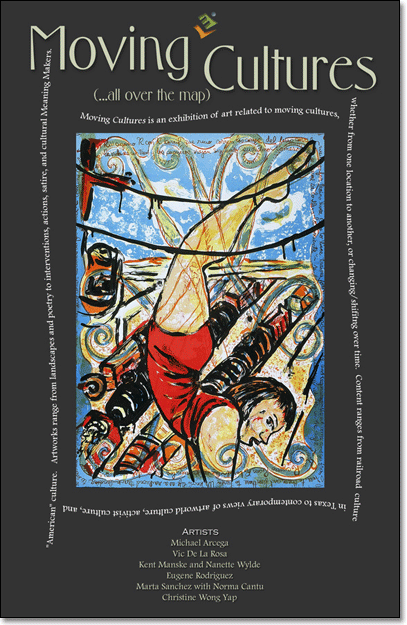
Railroad culture in Texas, the Mexican experience,
is the basis for the collaborative prints of artist
Marta Sanchez
and Chicana poet Norma Cantú. The Transcendental
Train Yard series, including serigraphs and
a large offset lithograph, address the history and
beauty of the train yards as a place of work, living
(cargo dwellings) and Vaudevillian troupes that
entertained the Mexican community in song, social
parodies, and circus acts. The colorful print R
cigarro R barril relates to a poem taken
from an old children's song about trains. The poem
was an offspring from the song and is still sung
by folklore singer Jose Luis Orozco. This piece
was one of the first Sanchez and Cantú worked on
and was printed at Philadelphia's Brandywine workshop.
The box set of serigraphs that they have been working
on is being printed by Coronado Studios in Austin,
Texas.
Texas railroad culture is also the basis of a mixed-media
Day of the Dead altar by Eugene
Rodriguez. Early in the 20th century Rodriguez's
grandparents traveled north to Chicago from Mexico,
worked on the railroads, then migrated west to California.
The Journey
pays homage to all who have come to this country
in search of a better life. And Rodriquez goes further.
Through text, he connects immigration and family,
corporate media and globalization, to address "transnational
citizenship, labor practices, and human rights".
Vic De La Rosa,
who innovates with technology and textiles, exhibits
provocative sarapes. His Verbal
Sarape series is jacquard woven. One sarape
reads: "is it
me? or just what I am wearing," words generally
applicable to our times of quick cultural assumptions.
While De La Rosa looks at Texas and other southwest
Mexican migrant populations, he focuses on cultural
assumptions, communication between cultures. Sometimes
cultures cross borders and other times the borders
themselves move, so De La Rosa also considers relationships
to land grabs, reparations, and turf wars.
Michael Arcega
exhibits work from his El
Conquistadork series, a humorous critique
on contemporary and historic issues of colonialism
and cultural exchange. Included are maquettes for
his 10' Manila galleon, made primarily of Manila
folders and successful sailed in Tomales Bay to
commemorate the famed intercontinental trade route
of 1565 through 1815 between Mexico City, Manila,
and California. Also on display is a huge map that
Arcega frames as a tool for conquest. "Historically,
the inhabitants of the drawn maps were unaware that
they have been subjected to one kingdom or another."
And flags, such as a Bear
Arms flag: "an essential tool in identifying
a group from other groups. It serves as a unifying
tool for the group under its banner, but it is divisive
in the same way." Arcega is one of a group of artists
participating in Galleon
Trade, a series of international arts exhibitions
(organized by Jenifer Wofford and Lucy Mae San Pablo
Burns, PhD), seeking to create new routes of cultural
exchange along old routes of commerce and trade.
Christine Wong
Yap also participated in Galleon
Trade. Regalos
is a transit-specific work involving "the shipment
of two empty, glitter-covered balikbayan boxes to
Manila. 'Balikbayan' is Tagalog for 'going home,'
and can refer to overseas Filipinos returning to
the mother country, or the large boxes of gifts
they customarily bring home." Wong Yap relates that
in transit to Manila the glitter eroded from the
boxes, suggesting a trail to home. Also during reentry
to the U.S., the boxes received new markings of
transit, including Homeland Security stickers. "Regalos"
is Tagalog (from Spanish) for "gift". Wong Yap reminds
us that art is a gift, even as she calls attention
to the heartfelt regalos
of the Filipino overseas labor force.
Kent Manske
and Nanette Wylde create a wonderful Meaning
Maker installation with pamphlets to make
sense of our changing culture(s). The American Citizenship
Edition provides a structure for "making the most
of your American experience." "Good for international
travel preparation; mental gymnastics; inspecting
bandwagons; endearing oneself to like-minded cronies;
reinforcing fear, loathing, and patriotism; and
adding spice to conversations." The Art Viewing
Edition and Academic Conference Edition give similar
insights into the art and academic worlds. And this
is just the beginning. The humorous and insightful
works are powerful tools for understanding and evaluating
our experiences.
What began with a story of migration grew to reflect
the cultural complexities of today - where many
of us are have family and connections "all over
the map" - and the resultant questioning of communication,
meaning, and values.
The exhibition was curated by Jan Rindfleisch working
with Nancy Hom, Consuelo Underwood, Christine Wong
Yap, with assistance from Diana Argabrite.
Spring
2007
Material
Culture
March 7 - April 19, 2007
Artists shown:
Reneé Billingslea,
Hector Dio Mendoza, Corinne Okada, Nazanin Shenasa,
Kerry Vander Meer
Artist community collaborators include Chike
Nwoffiah, Oriki Theater
Material
Culture connects a focus on textiles, both
traditional and contemporary practice, with a focus
on our culture of materials/materialism. In anthropology
and archaeology, material culture (physical objects
as opposed to documents) enables researchers to
better understand a culture. Playing off several
different title interpretations, we highlight six
artists with content relevant to the times and the
community.

Contemporary textile art is wide ranging. Artist
Reneé Billingslea
uses clothing to create an impact in her installation
Fabric of Race:
Lynching in America. Stained shirts, hanging,
with hand-embroidered nametags, represent cases
she researched. A hand-sewn quilt includes appropriated
images from "lynching postcards." Here clothing/textiles
stand in for the person and draws one into an important
but rarely discussed part of U.S. history and a
horrific part of human interactions that continues.
Billingslea teaches at Santa Clara University.
Artist Corinne
Okada creates wearable art and other art
objects from recycled candy wrappers from other
cultures, providing cultural links for different
generations. Her beautiful Nutcracker
Dress is constructed from Russian, Chinese,
Japanese, Brazilian, and Italian candy wrappers
along with produce bag netting, and bag ties. Her
Fear Kimono
is related to internment of Japanese Americans in
the US during World War II. It contains Japanese
paper dolls made of Executive Order 9066 documents,
Japanese candy wrappers, fishing line, and plastic
sushi grass. Okada also creates objects such as
flora and fauna from wrappers. Here the material
culture comes more into play because of the contrast
with the natural world we once knew. Okada received
a recent Artist of the Year award from Cupertino.
Chike Nwoffiah,
Director of Oriki
Theater in Mountain View, presents traditional
wearable art from the Igbos in southeast Nigeria.
Traditional garments are unique to each region and
reflect the status of the individual. The garments
displayed are often part of Oriki performances and
installations that relate to the music, dance, and
village life in Nigeria, where bright colors and
bold designs are ever present. Nwoffiah is partaking
in a drum/dance performance assembly at Nimitz Elementary
School, part of a Euphrat collaborative interdisciplinary
public artwork involving artists, De Anza students,
and elementary school students.
Kerry Vander
Meer takes women's contemporary clothing,
particularly the stretchy kind, and builds art installations
that overflow with creative energy of shape, lines,
and textures. And fun. For example, a portion of
her large installation Give
and Take alludes to both the restrictive/liberating
elements of pantyhose, sometimes stretched to the
limit, and also alludes to variations of give and
take in all kinds of social, economic, and political
interactions. Yet joyful whimsy encompasses all.
Vander Meer has exhibited widely and teaches at
Creative Growth Art Center in Oakland.
Hector Dio Mendoza's
artwork reflects various meanings to material culture.
Having worked with elderly women in care facilities
where he was collecting their stories, he noted
they often crocheted doilies as they talked. So
he dipped some of these in liquid concrete and created
solid sculptures, all white. A colorful version,
Atomic Landscape,
connects to contemporary issues of youth, with whom
Dio Mendoza also works. His wide-ranging community
involvement leads him to unusual content. In the
social sciences, "material culture" helps to understand
a culture. But in his mixed-media Scapegoat
(profiling), clothing, headgear, or hairstyle
can be used to distance people, stereotype, exclude,
and worse.
Nazanin Shenasa
exhibits a handmade silk costume, Layla's
Shroud, created for a performance and installation,
Permanent Madness,
2006. The work addresses the unconsummated love
between the ancient Middle Eastern lovers Layla
and Majnun. Shroud
is a response to the medieval Iranian prototype
of a noble woman suffering in silence. Here her
poetic thoughts come flowing out of the sleeves.
The concern of being separated from your dreams
is a universal one that still pertains today. Young
people often struggle with educational and life
decisions, conflicted as to whether to conform to
family or community expectations, or to follow their
heart to the true self. Shenasa is a textile artist,
art historian and curator who teaches at De Anza
College.
The exhibition was curated by Jan Rindfleisch working
with Nazanin Shenasa, with assistance from Diana
Argabrite.
Winter 2007
Changing
Still Life
January 22 - February 15, 2007
Artists shown:
DeWitt Cheng
and Susan Danis
Artist, campus and community collaborators include
Janet Leong
Malan, Connie Young Yu, Tom Izu (California History
Center), Annie Presler and Jose
Marte (De Anza Biological, Health, and Environmental
Sciences Division)
Changing
Still Life is an interactive exhibition comprised
of "still lifes" from which viewers can draw. These
still lifes encompass a variety of directions, with
objects reflecting different cultures and histories,
found/recycled objects, objects related to different
academic disciplines, and some artworks themselves.
Viewers have the opportunity to use viewfinders
and sketch on the spot.

While creating their artwork, participants will
be studying form, arrangement, and content. Objects
will be added and removed over time. Some aspects
of the arrangement can be adjusted. Movable lights
and viewfinders enable participants to change lighting
conditions and determine their compositions.
This changing still life imbues a classic art form
with contemporary and local relevance. The unusual
objects with wide-ranging content came from artists
and from sources on campus and in the community.
Artists Susan
Danis and DeWitt
Cheng display artwork and/or objects from
their studios. Danis's work, referring to consumerism
and the environment, is constructed of recycled
materials, sometimes conglomerations of synthetic
fuzzies, beads, fake hair, plastic and rubberized
parts in garish hues, pinks and greens. Cheng's
art relates to science specimens. He morphs these
into unique creatures and attaches titles that draw
one into larger contemplations.
Community participation yielded historical objects
from Connie
Young Yu and Janet
Leong Malan. Historian Young Yu offers a
trunk and artifacts related to early Chinese-American
history in the area, items from her family's collection,
including a pair of slippers for bound feet belonging
to her grandmother. Some items go back to the 1880s.
For example, from the Route 87 upgrade, she recovered
a liquor jug that was from the Woolen Mills Chinatown
(1887-1902). Artist Leong Malan's objects reflect
family history in Cupertino: a drilling tool, heart-shaped
hoe, abacus used until the '70s, her grandfather's
incense burner, business ledgers, and immigration
papers. Her family was the first Chinese family
to settle in Cupertino (1952), developing a successful
flower-growing business.
Campus input included architectural elements salvaged
by the California
History Center (CHC) as time and new construction
are changing the historic face of De Anza. French-style
doors were salvaged from the West Cottage, recently
demolished in an expansion project. Designed by
architect Willis Polk for the Baldwin estate circa
1895, it served as guest and servant quarters for
the main house currently housing the CHC. Director
Tom Izu:
"De Anza College owes its 'Spanish California' architectural
theme and archway logo to elements in the two original
Mission Revival style cottages." Restoration plans
for the remaining cottage are under development.
A sheep's horn, a whale vertebra, and turtle shell
from the De
Anza Biological, Health, and Environmental Sciences
Division, courtesy of Laboratory Technician
Jose Marte,
are incorporated. Microscopic specimens, animal
bones, insect collections, and anatomical models
enable concentration on the natural world, in its
own struggle with urban development. Faculty member
Annie Presler
has provided native plants for display. These relate
to De Anza's Environmental
Studies Center (next to the Kirsch Center),
a 1.5-acre arboretum showcasing California's native
plant communities and promoting native plant usage
in landscaping.
As new items are added, e.g. plants, or books or
text-based materials, participants will have added
opportunities to consider individual objects, partial
views, and juxtapositions to develop their content
and individual statements - whether by drawing,
photography, or poetry.
The Euphrat Museum is in an interim space in the
A quad while the design of the new Euphrat building
is being finalized and construction proceeds. For
this exhibition, some basic sketch materials will
be provided. Other individual projects, class assignments
or visits need to be coordinated with the Museum.
Fall 2006
DeAnza
and Foothill Art Faculty/Staff Exhibition
Exhibition opened November 14th, and ran
through December 7th.
Reception with artists' presentations November 28th,
6-8PM.
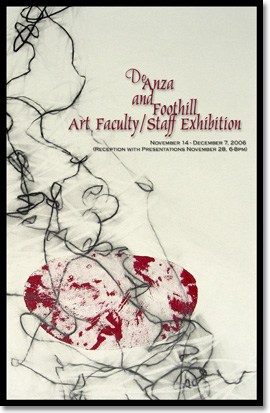
Fall 2004
Edges
highlighted formal solutions and also explored edges
with respect to timely content, whether on a personal,
regional, or global level. In his Visual
Quotations series, Titus
Kaphar worked from selected 19th century
paintings but only painted the African Americans.
He worked in oils on dry-erase whiteboards with
all the surrounding area left white. A hard edge
separated the two. Diana Pumpelly Bates' bronze
sculptures focused on the edge between physical
and spiritual worlds. Photographer Julian
Cardona's works documented the violent entry
of Mexico to globalization and probed inside the
maquiladora world alongside the border. His series,
Dying Slowly
showed difficult edges: the border between life
and death, death in life. In another series, THE
TRUTH, Evidence of a Failure, he documented
family members searching for the bodies of their
daughters in the desert. Lucy
Arai created soft and hard edges by applying
sumi ink in washes on handmade paper and then employing
sashiko,
traditional Japanese running-stitch embroidery,
in concentric circles and fluid patterns. Consuelo
Underwood drew directly on the wall, included
wrapped shaman sticks, and created an unusual red
leather grid that looked like barbed wire. It referred
to the ten sites where the U.S. government has constructed
a 14' steel wall to secure the Mexico/U.S. border.
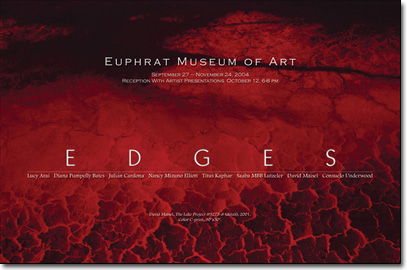
Spring 2004
City
Life presented art related to the urban experience.
It highlighted urban transportation, work, architecture
(buildings, landscape, and interiors), public art,
neighborhoods, and life styles. Lewis
Watts showed photographs of urban life in
Oakland, selections from his series Evidence:
The Oakland Cultural Landscape Project. Jessica
Dunne created paintings of urban night scenes,
including parking lots and freeways. Seyed
Alavi photographed numerous people on Market
Street in San Francisco and layered their facial
images, six at a time, to create composite images
displayed as large kiosk posters. Harriete
Estel Berman's nine-foot-square sculpture
of "grass" constructed from recycled tin consumer
products called attention to the rampant consumerism
in our city malls. Large photographs of Tokyo subway
scenes by Kim
Yasuda explored ideas of personal and public
space in Japanese cities. Katherine
Aoki created something new, an active urban
world populated with women who provoke us to challenge
gender-related expectations.
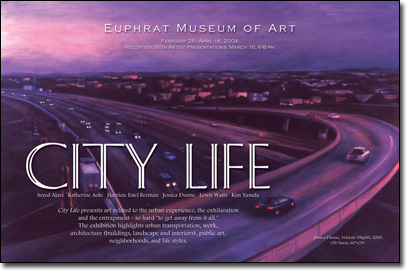
|